 Mitchum packs everything he needs for traveling except his sleuthing hat. 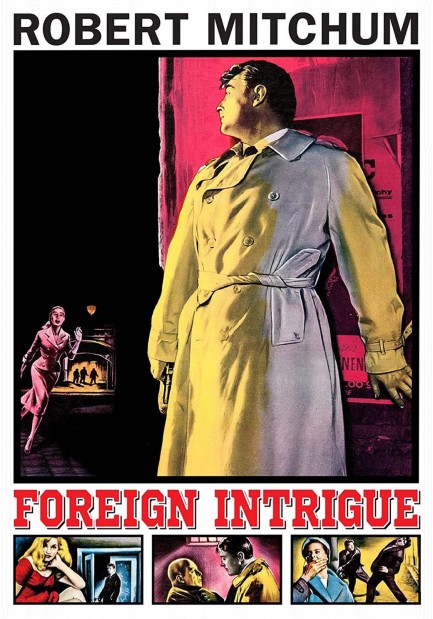
This beautiful poster for the Robert Mitchum thriller Foreign Intrigue is yet another framable delight from the golden age of Hollywood. Wikipedia calls this movie a film noir, but genre designations are often wrong there and on IMDB. This is actually a spy movie, often light in tone, sort of like the later films Charade and Arabesque. Mitchum is an American in Paris working as a press agent for a reclusive one percenter. When his employer dies of a heart attack, Mitchum comes to believe there was more to the death than a blown ventricle. He follows a trail of clues from the French Riviera to Vienna and Stockholm, which is where the foreign part of Foreign Intrigue comes in. The intrigue part? Well, that never fully develops. In fact, the movie falls back on the cliché of having the villains explain their plot to the protagonist. It has to do with money, blackmail, traitors, and Hitler. Trust us, it's not as interesting as it sounds. Compounding the narrative problems is a dopey soundtrack and a Mitchum who's short on charm here. The flirtations between him and Swedish love interest Ingrid Thulin are solid wood. She went on to win Best Actress at the 1958 Cannes Film Festival, which goes to show that half of acting is screenwriting. Are there any saving graces to Foreign Intrigue? Of course. It's well shot, atmospheric, cast with international actors and their wonderful accents, and is a nice travelogue, encompassing Mediterranean villas, Vienna backstreets, and Swedish lakes, all in lush Eastmancolor. And Mitchum is watchable even in a film that mostly wastes his considerable star power. Intrigued? Then go for it. Foreign Intrigue premiered today in 1956. 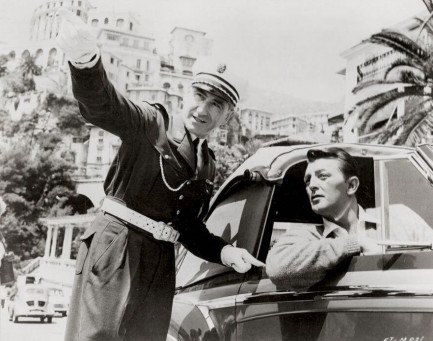 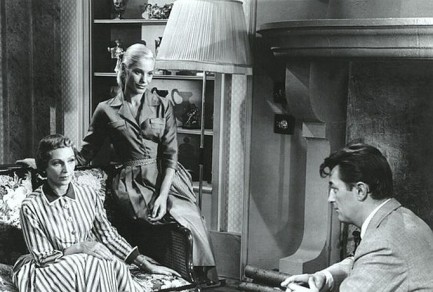 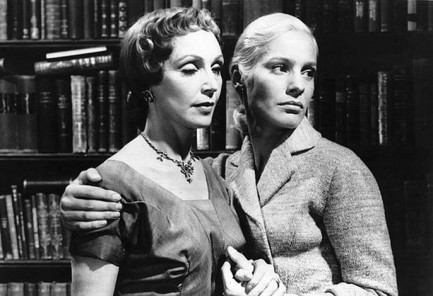 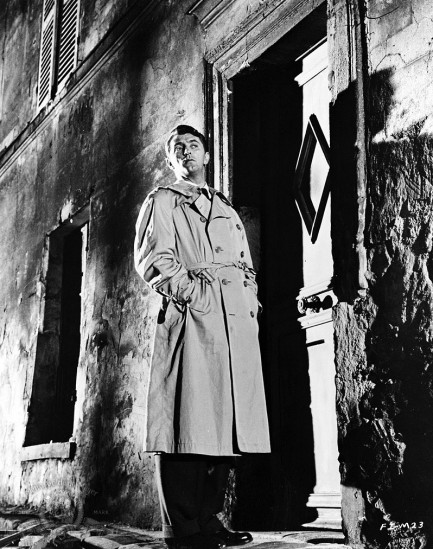 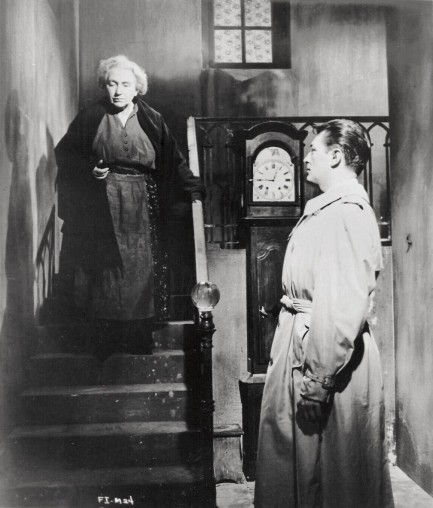 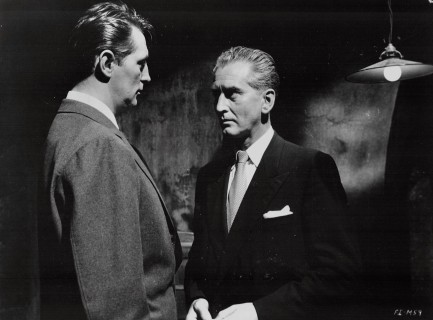 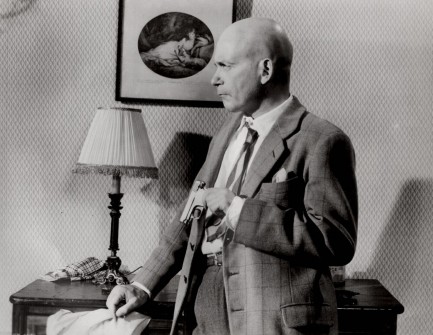 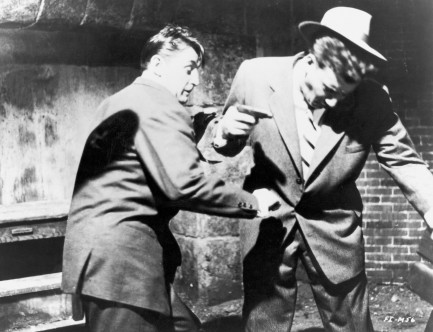 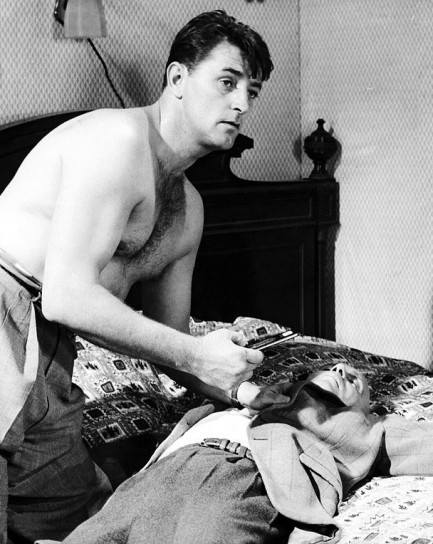  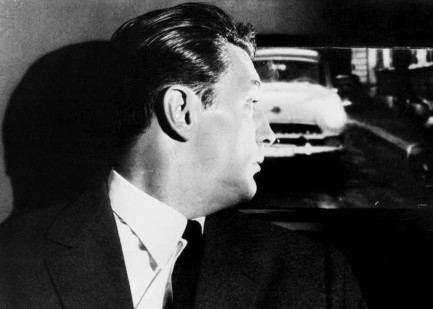 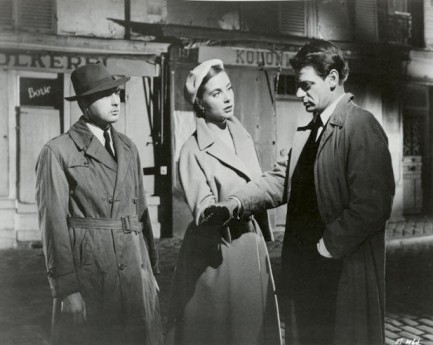 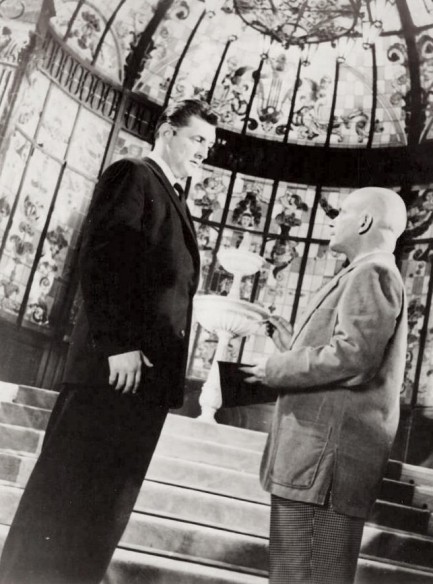 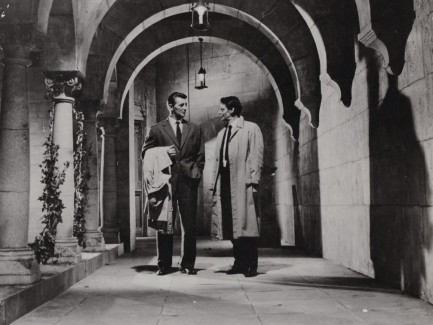 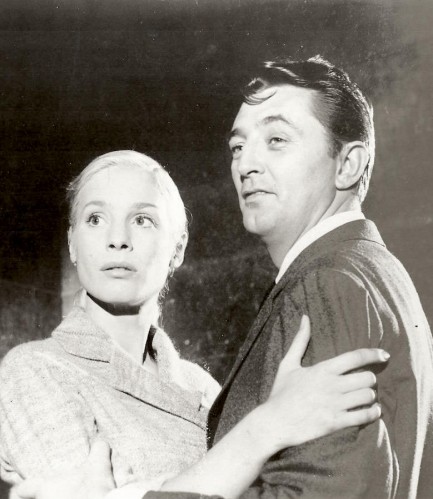 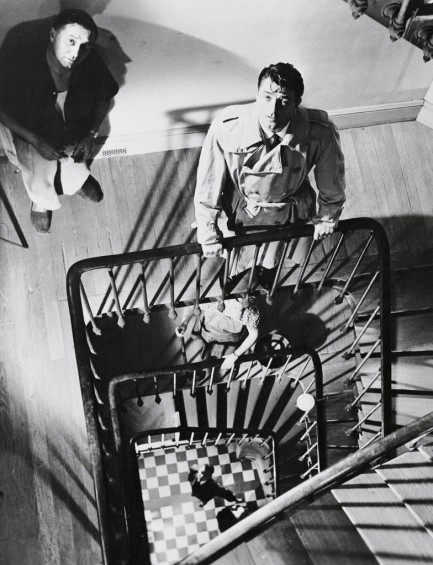
 They say white is appropriate only for your first shooting, but you know what? Screw convention. 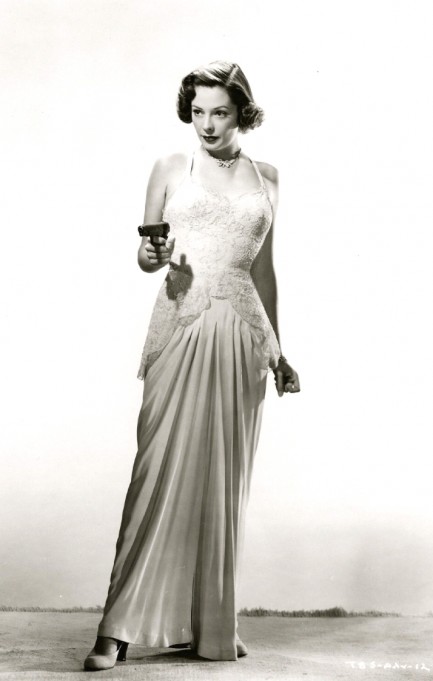
We last saw Jane Greer using a gun in a promo image we shared from the 1947 film noir classic Out of the Past, and here she is waving one around again in a shot made when she starred in 1949's The Big Steal, which reunited her with Out of the Past leading man Robert Mitchum. We haven't seen The Big Steal, but it's on the list now.
 Does this look like the face of a homicidal maniac? 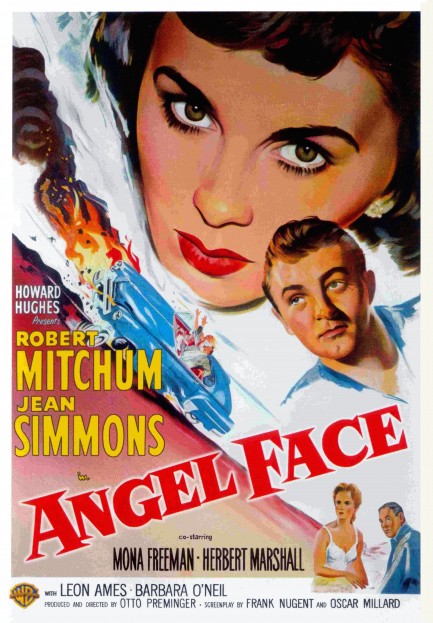 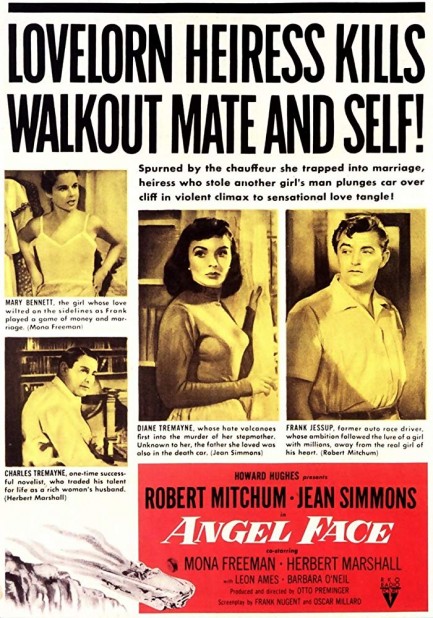
Above are two nice posters for the film noir Angel Face, starring Jean Simmons as an incredibly sneaky nineteen-year-old who wants to kill her stepmother, and Robert Mitchum as a hapless chauffeur who finds himself sucked into the plot. The movie opened in the U.S. today in 1953. The bottom poster, made to look like a tabloid cover, in true tabloid style gives everything away. We debated posting it, but decided to do it for historical purposes, because this is the only promo poster we've ever seen that explicitly gives away the ending of the film it promotes. Is it still worth watching? We think so.
 She was a very intriguing star. 
Swedish actress, director, and screenwriter Ingrid Thulin perches on a chair in this blonde on black promo image from 1956. She's best known for appearing in several Ingmar Bergman movies, including 1957's Smultronstället, also known as Wild Strawberries. Interestingly, Thulin guested on a U.S. spy series called Foreign Intrigue in 1954 and 1955, and the next year co-starred in the spy thriller Foreign Intrigue with Robert Mitchum, a movie that was unrelated to the television show despite its identical title. We guess the casting agent must have been like, “So, Ingrid, can you be intriguing? Just kidding. I see on your credits that you've been there, done that, so you're hired.”
 Up and coming actress gets weeded out of Hollywood. 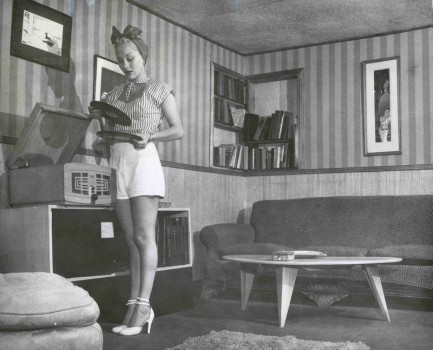
It was during wee hours, today in 1948, that fledgeling actress Lila Leeds was arrested, along with Robert Mitchum and two others, for possession of marijuana. The photo above was shot at her Hollywood bungalow a few days later to accompany a Los Angeles Times article about the arrest. Leeds was out on bail, and was given the opportunity to explain the circumstances around that fateful night. Her home had been portrayed in newspaper accounts as a party spot for drug users, a characterization she denied. She explained to Times readers that she'd rented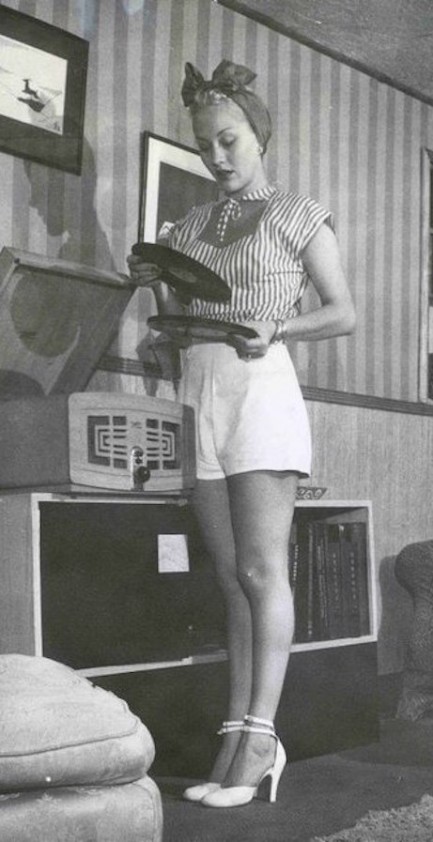 the place because it was feminine, and because it had space for her two dogs. She also admitted that she used marijuana, which considering she hadn't gone to trial yet maybe wasn't a great idea. the place because it was feminine, and because it had space for her two dogs. She also admitted that she used marijuana, which considering she hadn't gone to trial yet maybe wasn't a great idea.
When Leeds had her day in court she was convicted of “conspiring to violate state health laws,” and sentenced to sixty days in jail. Robert Mitchum went to jail too, and fretted that his career had been ruined, but it was Leeds who never got another shot in Hollywood, apart from a role in the 1949 drug scare movie Wild Weed, aka The Devil's Weed, aka She Shoulda Said No. And indeed, she probably shoulda said no, because in 1948 a woman who got out of her lane was always severely punished if caught. But even if the drug conviction cost Leeds her career, she remains part of Hollywood lore, and though that's small consolation, it's still more than most can claim. 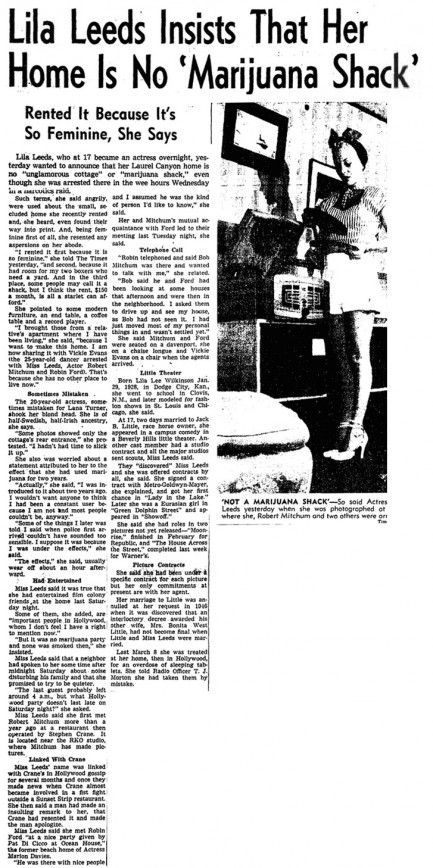 
 You know what I love about you, Jane? You're as hot as me. It's like I switched my gender with FaceApp. 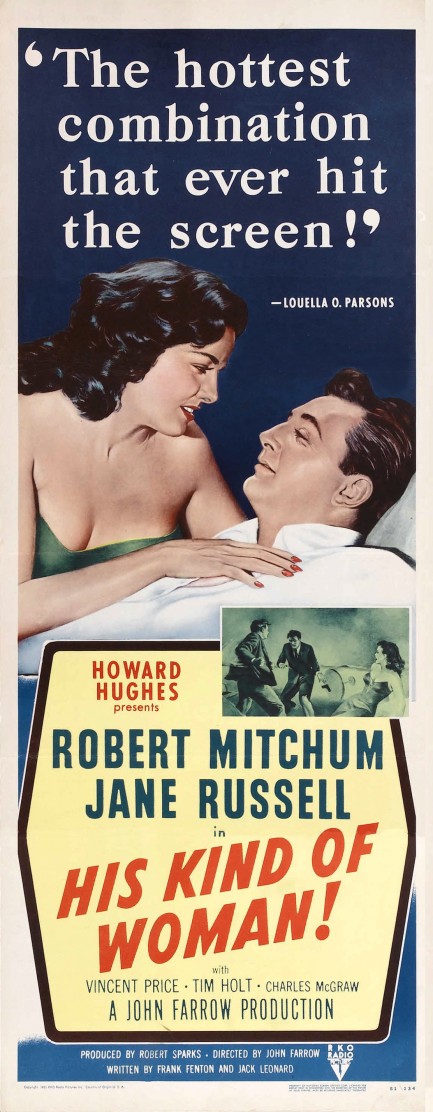
The promo poster for the classic film noir His Kind of Woman declares Jane Russell and Robert Mitchum the hottest combination ever to hit the screen. The windscreen? The screen door? We'll assume it means the silver screen. The movie was made by RKO Radio Pictures when it was run by Howard Hughes, so if you know anything about vintage cinema you already know this production was a mess. Hughes' micromanaging, meddling, and firings of actors led to heavy cost overruns and more than an hour of retakes. Despite these issues Mitchum and Russell do fine as the romantic leads, and support from Vincent Price, Jim Backus, and Raymond Burr helps them immensely. Are they the hottest whatever to hit the whatever? Well, of course. They'd be the hottest pushing a stalled car up a hill, or flossing their rearmost molars, or yakking in the toilet after an all night tequila binge. When you're hot, you're hot. We know quite well because—not to boast—people have said the same about us.
Anyway, Mitchum plays a classic film noir patsy who accepts a pile of money to go to Mexico for unknown purposes, only to discover that the sweet deal he thought he was getting isn't so sweet after all. Russell plays a rich girl idling down south with her lover, a famous actor, but when she gets a gander of Mitchum she starts rethinking her romantic priorities. Any smart woman would. We won't reveal the plot other than to say it's adequate, though not awe inspiring. The last few reels make a hard right turn into comedy, which some viewers hate, but the major problem for us is that the ineptness of the villains during the extended climax strains credulity. In the end His Kind of Woman may not be your kind of movie, but guys (or girls) get to see Russell dress slinkily and sing a couple of songs, and girls (or guys) get to see Mitchum go about twenty minutes with no shirt, so there's a silver lining for everyone here. The film premiered in the U.S. today in 1951.
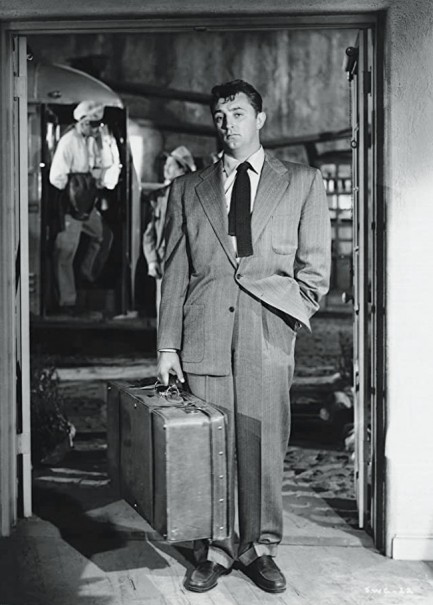 Do you have someplace I can store this suitcase filled with my excess masculine heat? Do you have someplace I can store this suitcase filled with my excess masculine heat? 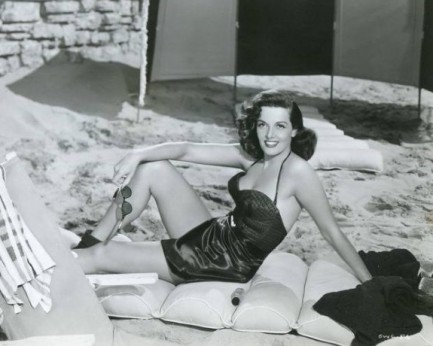 Sure, you can sit next to me. But first you have to sign a liability waiver in case you get scorched. Sure, you can sit next to me. But first you have to sign a liability waiver in case you get scorched. 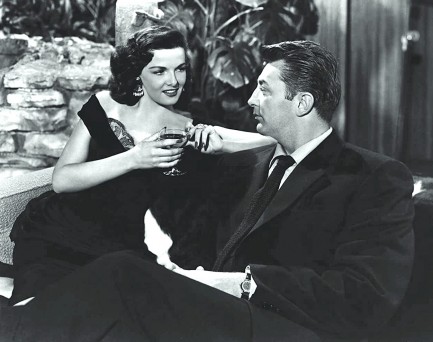 You'll love this next trick. I put my finger in this cognac and it catches fire. You'll love this next trick. I put my finger in this cognac and it catches fire. 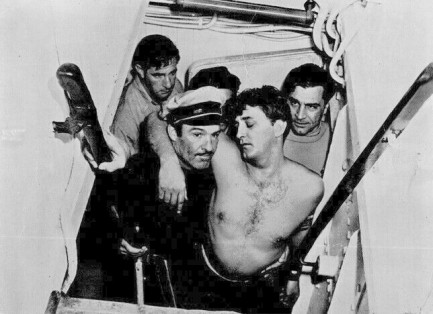 Hot as this guy is, I don't know whether to keep beating on him or start beating on me. Hot as this guy is, I don't know whether to keep beating on him or start beating on me. 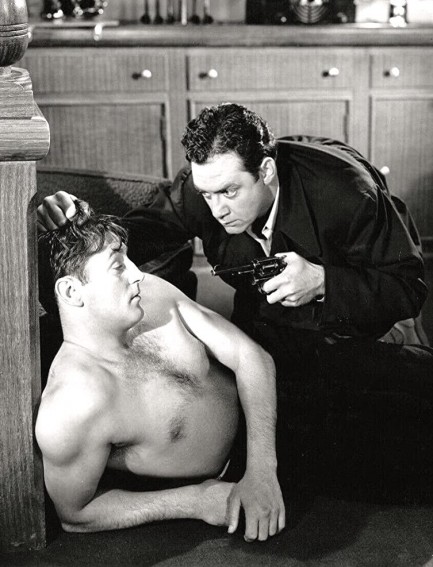 And once I take your face off I'll be the hot one. I'll have it all! Respect, envy, women, excellent service wherever I go! The world will be mine! Mwahh hah hah! Haaaaaaaah haha hahah! And once I take your face off I'll be the hot one. I'll have it all! Respect, envy, women, excellent service wherever I go! The world will be mine! Mwahh hah hah! Haaaaaaaah haha hahah!
 Hitchcock says no festival for you this year! 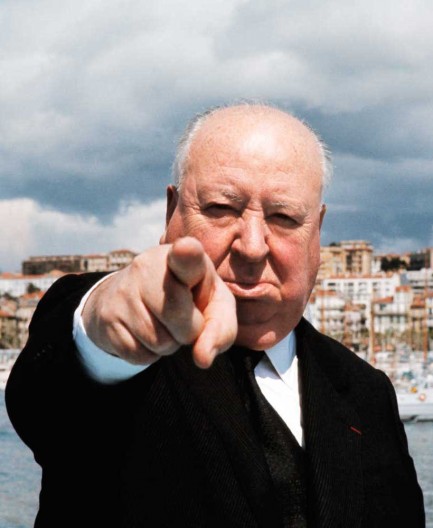
The 73rd edition of the Festival de Cannes, aka the Cannes Film Festival, would have kicked off today in the south of France, but was cancelled a while back. It's just one of a wave of event cancellations that will cascade through the year. Festivals as diverse as Burning Man and San Fermin, aka the Running of the Bulls, have also been shelved. But getting back to Cannes, we thought this would be a good moment to commemorate past fests with some historical photos. Above you see Alfred Hitchcock on a boat with the town in the background, in 1972, and below are about fifty pix from the 1940s through 1970s, documenting various iconic moments, and a few quieter ones. Maybe the Cannes Film Festival will back next year, maybe not. At this point, predicting anything is an exercise in futility. But at least we'll always have the memories. 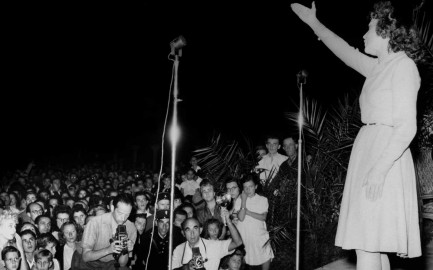 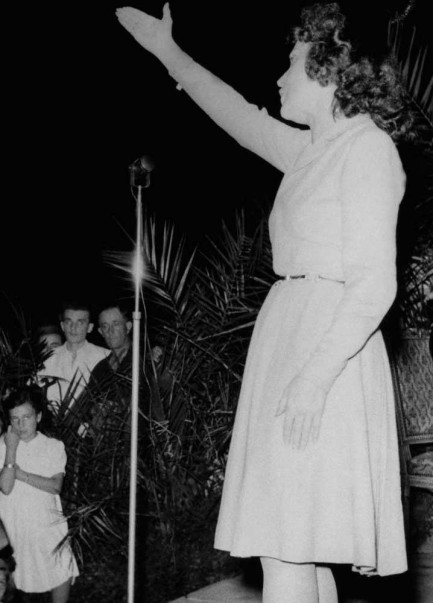 Edith Piaf sings on the terrace of the Carlton Hotel on the iconic Boulevard de la Croisette at the first Festival de Cannes to be held under that name, in 1946. Back then the event took place in September and October, but would shift to May a bit later. Edith Piaf sings on the terrace of the Carlton Hotel on the iconic Boulevard de la Croisette at the first Festival de Cannes to be held under that name, in 1946. Back then the event took place in September and October, but would shift to May a bit later.
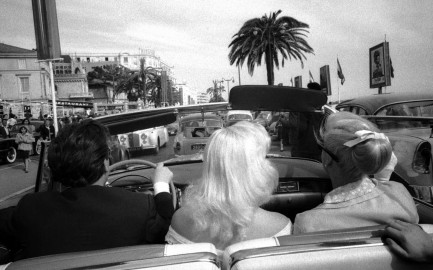 Diana Dors and Ginger Rogers arrive at the fest the only way anyone should—breezing along the beachfront in a convertible, in 1956, with an unknown driver. Diana Dors and Ginger Rogers arrive at the fest the only way anyone should—breezing along the beachfront in a convertible, in 1956, with an unknown driver.
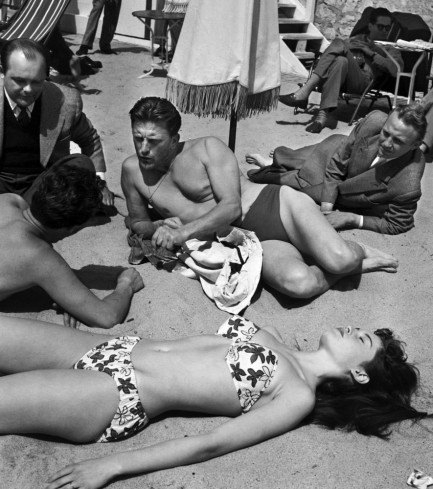 Kirk Douglas holds court on the beach in 1953, and Brigitte Bardot soaks up rays in the foreground. Kirk Douglas holds court on the beach in 1953, and Brigitte Bardot soaks up rays in the foreground.
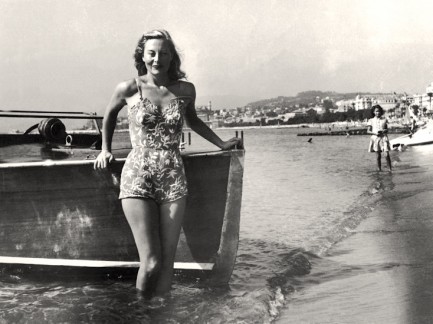 Michele Morgan poses at the first Festival in 1946. Photo ops of this sort were essential sources of publicity for stars, and would soon become opportunities for non-stars seeking to be discovered. Michele Morgan poses at the first Festival in 1946. Photo ops of this sort were essential sources of publicity for stars, and would soon become opportunities for non-stars seeking to be discovered.
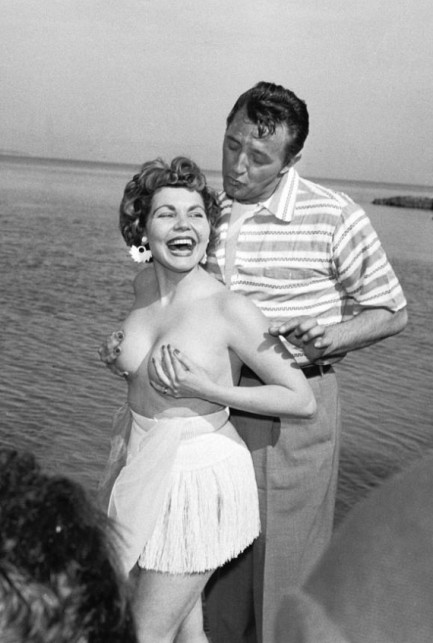 Case in point. Robert Mitchum poses with actress Simone Sylva in 1954. Sylva was allegedly not supposed to be there, but shucked her top and photo-bombed Douglas in an attempt to raise her profile. It didn't work. She made only a couple of credited movie appearances after her topless stunt. Case in point. Robert Mitchum poses with actress Simone Sylva in 1954. Sylva was allegedly not supposed to be there, but shucked her top and photo-bombed Douglas in an attempt to raise her profile. It didn't work. She made only a couple of credited movie appearances after her topless stunt.
 Romy Schneider and Alain Delon at the 1959 fest. Romy Schneider and Alain Delon at the 1959 fest.
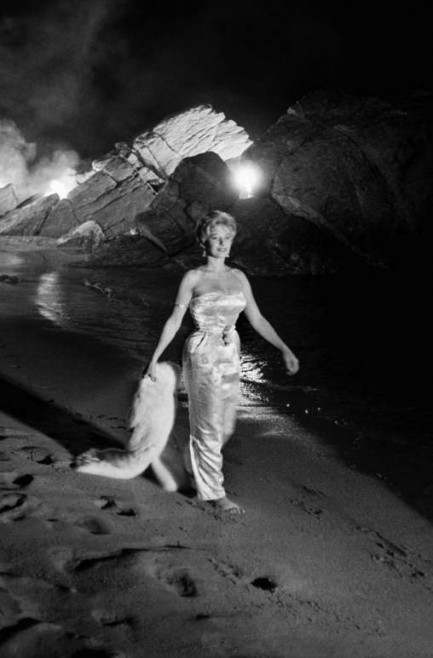 An unidentified model or actress poses in the style of Anita Ekberg from La dolce vita in 1960. This looks like it was shot at Plage du Midi, which is a beach located a little ways west of the Cannes town center. An unidentified model or actress poses in the style of Anita Ekberg from La dolce vita in 1960. This looks like it was shot at Plage du Midi, which is a beach located a little ways west of the Cannes town center. 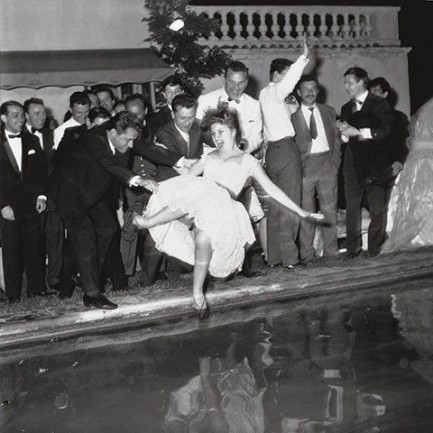 A unidentified partygoer is tossed into a swimming pool after La Dolce Vita won the the 1960 Palme d’Or. The Festival is almost as well known for legendary parties as for legendary film premieres. A unidentified partygoer is tossed into a swimming pool after La Dolce Vita won the the 1960 Palme d’Or. The Festival is almost as well known for legendary parties as for legendary film premieres.
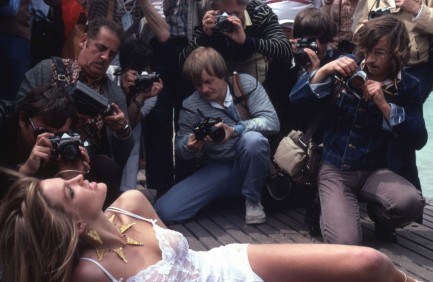 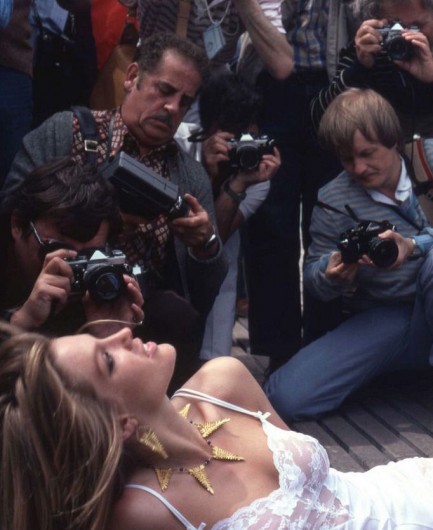 Another unidentified model or actress poses on the boardwalk in 1979. Generally, you don't have to be known to draw a crowd of photographers—you just have to be nearly bare. She's wearing lingerie, so that explains the interest, though this is modest garb for a Cannes publicity stunt. It's never a surprise to see a headline-seeking film hopeful strip all the way down to a string ficelle féminin, or thong, which is the limit of what is legal in Cannes Another unidentified model or actress poses on the boardwalk in 1979. Generally, you don't have to be known to draw a crowd of photographers—you just have to be nearly bare. She's wearing lingerie, so that explains the interest, though this is modest garb for a Cannes publicity stunt. It's never a surprise to see a headline-seeking film hopeful strip all the way down to a string ficelle féminin, or thong, which is the limit of what is legal in Cannes
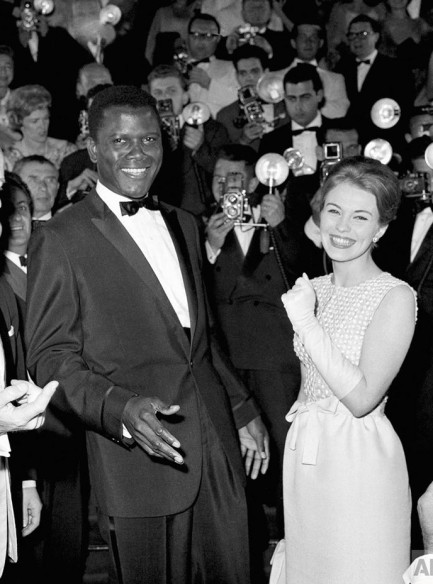 Sidney Poitier and Jean Seberg have a laugh in 1961. This was the year Poitier's flick Paris Blues was released, so it's possible he had jetted down from the capital for the Festival. Sidney Poitier and Jean Seberg have a laugh in 1961. This was the year Poitier's flick Paris Blues was released, so it's possible he had jetted down from the capital for the Festival.
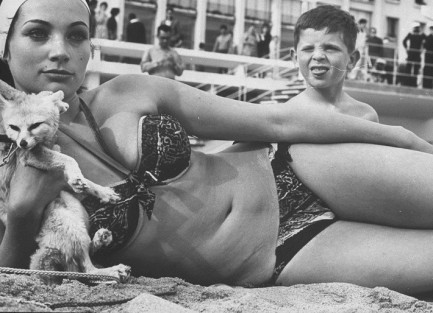 Philomène Toulouse relaxes on the sand in 1962 while a boy practices the classic French look of disgust he'll be using the rest of his life. Philomène Toulouse relaxes on the sand in 1962 while a boy practices the classic French look of disgust he'll be using the rest of his life.  Actor Bernard Blier, 1975. Actor Bernard Blier, 1975.  An unidentified bikini wearer boldly enjoys a lunch in a café on the Croisette, 1958. An unidentified bikini wearer boldly enjoys a lunch in a café on the Croisette, 1958. 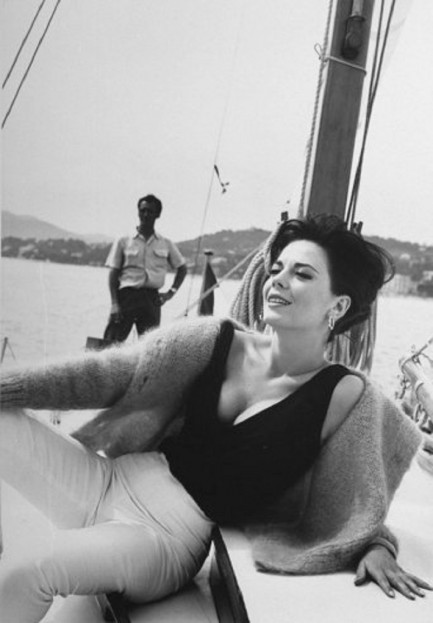 Natalie Wood aboard a sailboat in 1962. Natalie Wood aboard a sailboat in 1962.
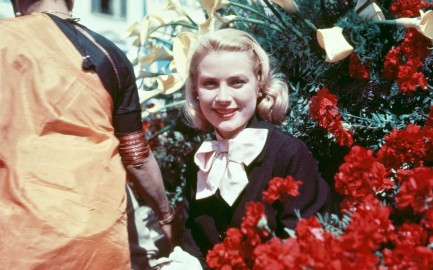 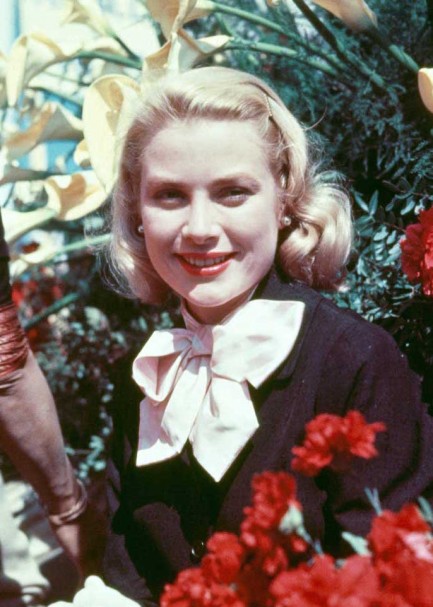 Grace Kelly, 1955. Grace Kelly, 1955.
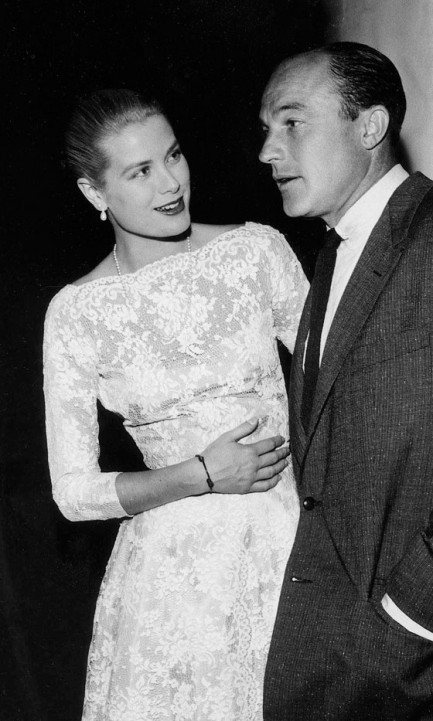 Kelly times two—Grace Kelly and Gene Kelly, hanging out, also in 1955. Kelly times two—Grace Kelly and Gene Kelly, hanging out, also in 1955.
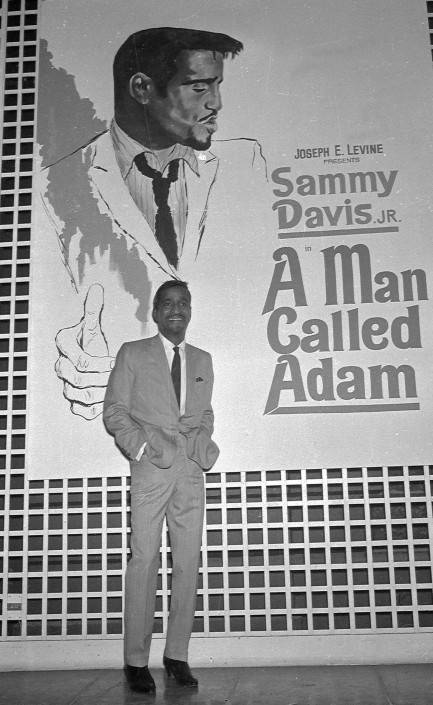 Sammy Davis, Jr. poses in front of a billboard promoting his film A Man Called Adam, 1966. Sammy Davis, Jr. poses in front of a billboard promoting his film A Man Called Adam, 1966. 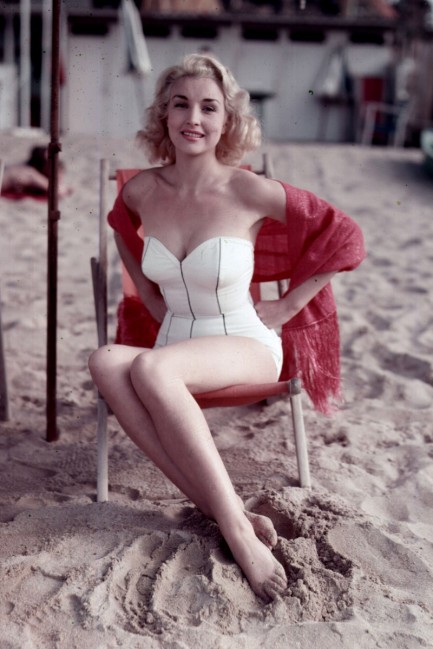 Joan Scott gets sand between her toes in 1955. Scott is obscure. She isn't even the most famous Joan Scott anymore. The IMDB entry for the only Joan Scott near the appropriate age is for an actress born in 1920 who didn't begin acting until 1967. The Joan Scott above doesn't look thirty-five, though, and we doubt she would have been the subject of this somewhat well-known photo without parlaying it into a film appearance before twelve years had passed. So we don't think this is the Joan Scott referenced on IMDB. Joan Scott gets sand between her toes in 1955. Scott is obscure. She isn't even the most famous Joan Scott anymore. The IMDB entry for the only Joan Scott near the appropriate age is for an actress born in 1920 who didn't begin acting until 1967. The Joan Scott above doesn't look thirty-five, though, and we doubt she would have been the subject of this somewhat well-known photo without parlaying it into a film appearance before twelve years had passed. So we don't think this is the Joan Scott referenced on IMDB.  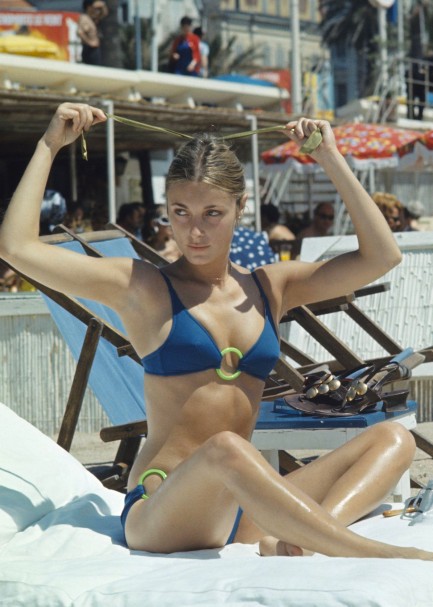 Sharon Tate, with Roman Polanski, and solo, 1968. Sharon Tate, with Roman Polanski, and solo, 1968.
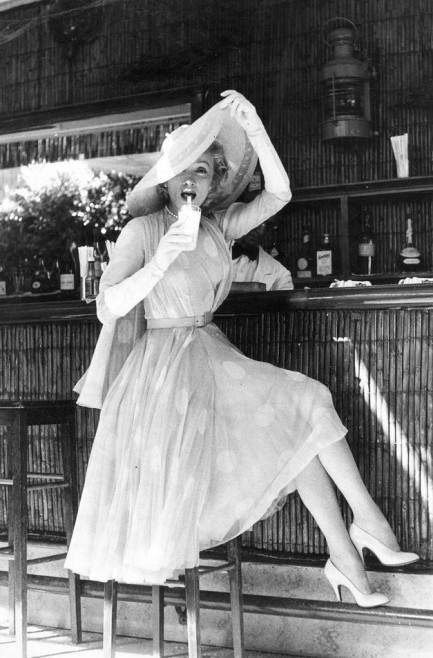 Marlene Dietrich brings glamour to a tiki themed bar in 1958. Marlene Dietrich brings glamour to a tiki themed bar in 1958.
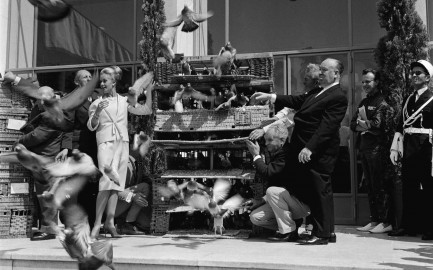 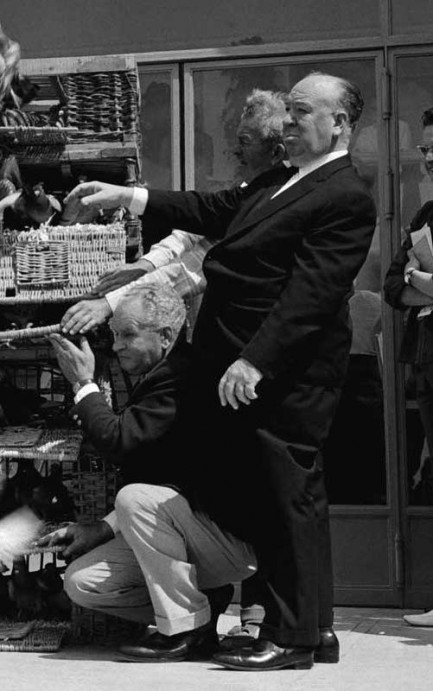 Tippi Hedren and Alfred Hitchcock release caged birds as a promo stunt for The Birds in 1963. Tippi Hedren and Alfred Hitchcock release caged birds as a promo stunt for The Birds in 1963.
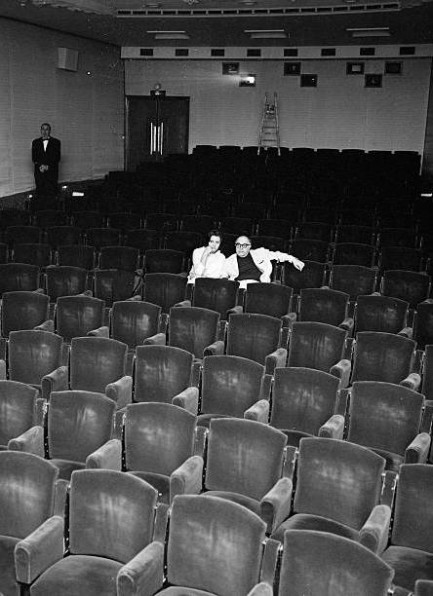 Sophia Loren sits with husband Carlo Ponti, who was a member of the 1966 Festival jury. Sophia Loren sits with husband Carlo Ponti, who was a member of the 1966 Festival jury.
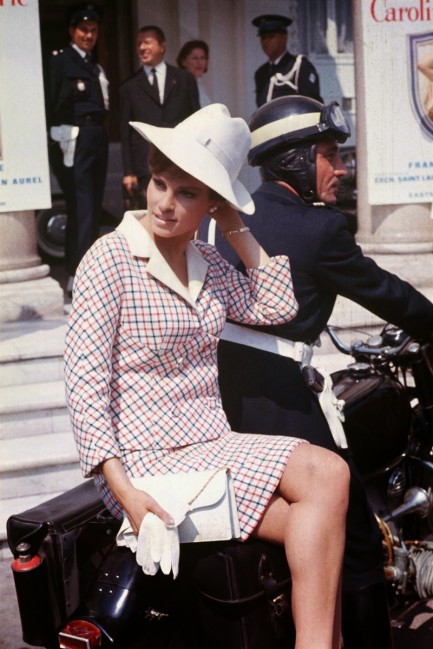 Raquel Welch poses on a motorcycle in 1966. Raquel Welch poses on a motorcycle in 1966.
 Jane Birkin takes aim with one of her cameras in 1975. Jane Birkin takes aim with one of her cameras in 1975. 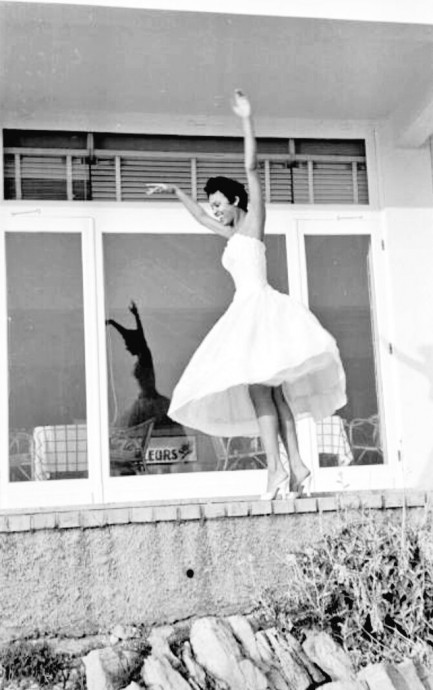 Dorothy Dandridge frolics in 1955, when she was promoting her film Carmen Jones. Dorothy Dandridge frolics in 1955, when she was promoting her film Carmen Jones.
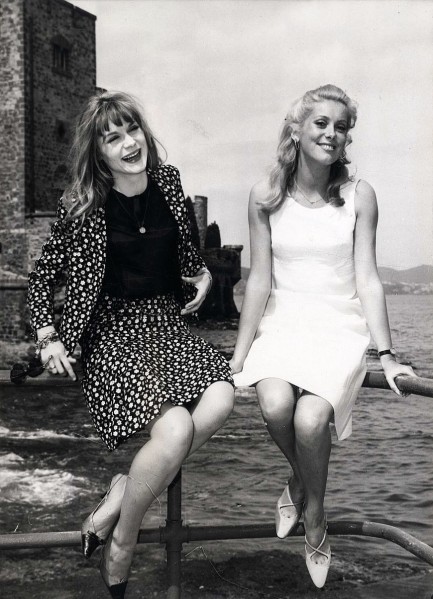 Cinematic icon Catherine Deneuve and her sister Françoise Dorléac in 1965. Dorléac died in an automobile accident a couple of years later. Cinematic icon Catherine Deneuve and her sister Françoise Dorléac in 1965. Dorléac died in an automobile accident a couple of years later. 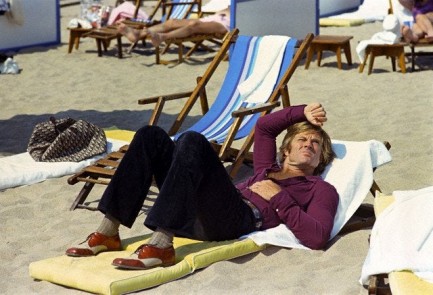 Robert Redford lounges on the beach in 1972. Based on his outfit you'd think he was in Cannes to promote The Sting, but he was actually there for his western Jeremiah Johnson, which screened May 7 of that year. Robert Redford lounges on the beach in 1972. Based on his outfit you'd think he was in Cannes to promote The Sting, but he was actually there for his western Jeremiah Johnson, which screened May 7 of that year.
 Sophia Loren waves to well-wishers in 1964. Sophia Loren waves to well-wishers in 1964.
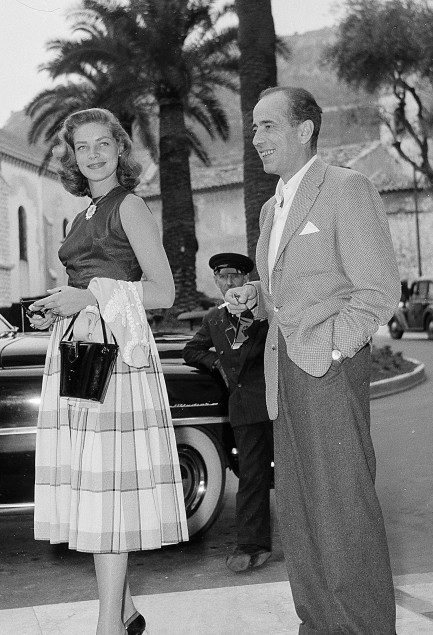 Bogie and Bacall paired up and looking distinguished in 1957. Bogie and Bacall paired up and looking distinguished in 1957.
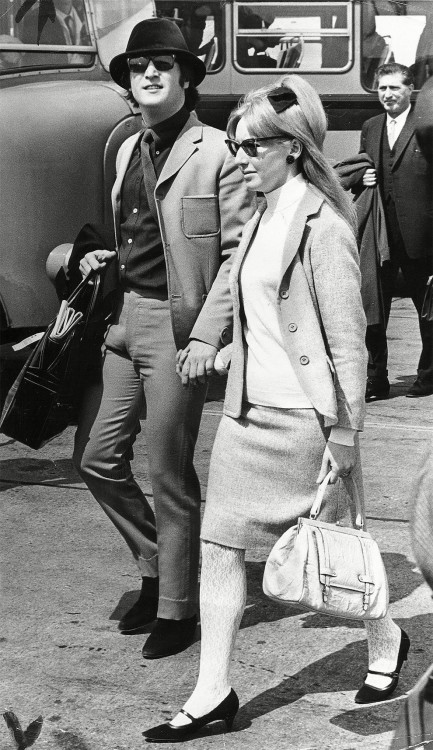 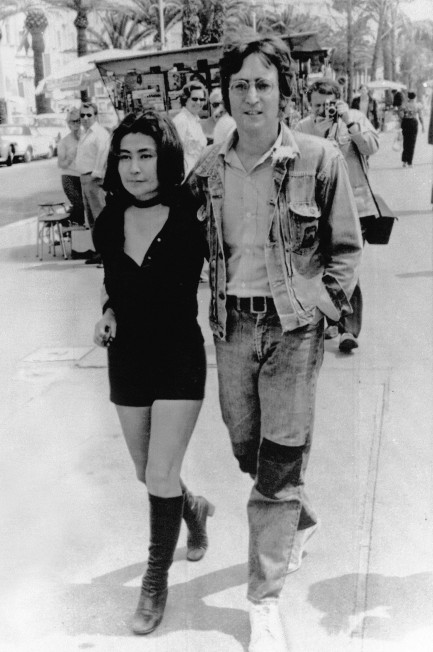 John and Cynthia Lennon in 1965, and John with Yoko Ono in 1971. Every story John told on that second trip probably started with, “When I was here with the first love of my life...” until Yoko smacked him across the mouth. John and Cynthia Lennon in 1965, and John with Yoko Ono in 1971. Every story John told on that second trip probably started with, “When I was here with the first love of my life...” until Yoko smacked him across the mouth.
 Rock Hudson and bicycle in 1966. Rock Hudson and bicycle in 1966.
 Unidentified actresses pose on the beach in 1947. To the rear is the Hotel Carlton, mentioned in the Edith Piaf image, built on the Croisette and finished in 1910. Unidentified actresses pose on the beach in 1947. To the rear is the Hotel Carlton, mentioned in the Edith Piaf image, built on the Croisette and finished in 1910.
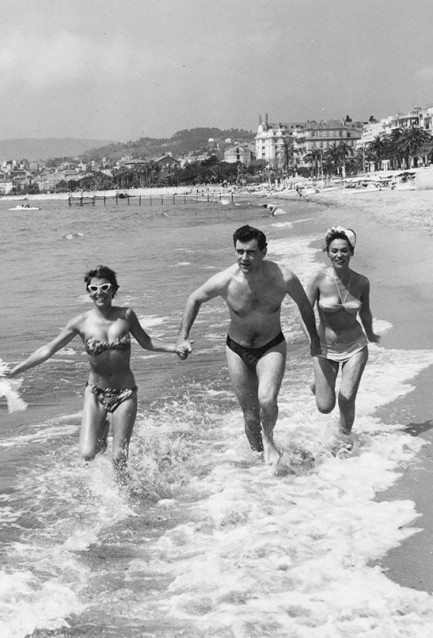 George Baker, Bella Darvi (right—your right, not his), and an unknown acquaintance have a surfside run/photo op in 1956. George Baker, Bella Darvi (right—your right, not his), and an unknown acquaintance have a surfside run/photo op in 1956.
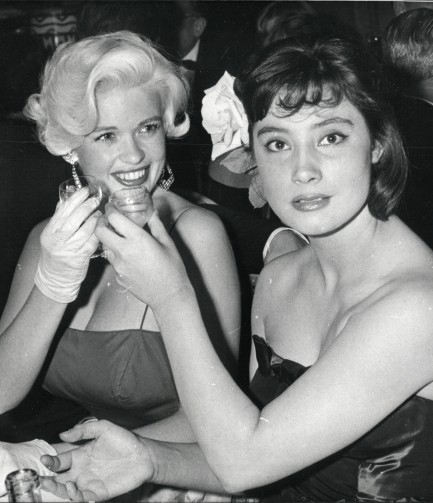 Jayne Mansfield and Russian actress Tatiana Samoïlova enjoy a toast in 1958. Mansfield probably shared the story of how she once made Sophia Loren stare at her boobs, and Samoïlova said, “Cheers to you—well played, you provocative American minx.” Jayne Mansfield and Russian actress Tatiana Samoïlova enjoy a toast in 1958. Mansfield probably shared the story of how she once made Sophia Loren stare at her boobs, and Samoïlova said, “Cheers to you—well played, you provocative American minx.”
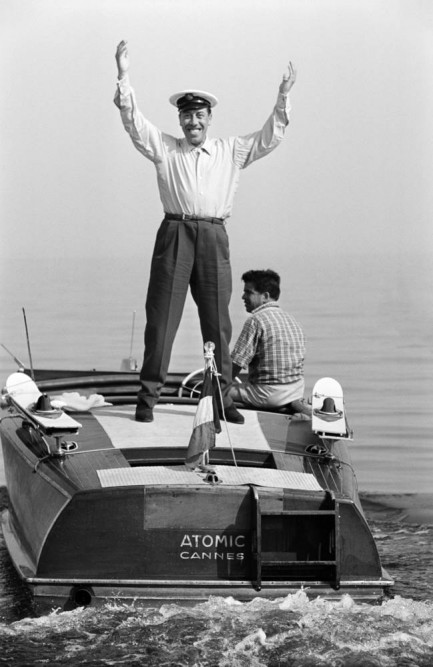 French actor Fernandel, whose real name was Fernand Contandin, on his boat Atomic in 1956. French actor Fernandel, whose real name was Fernand Contandin, on his boat Atomic in 1956.
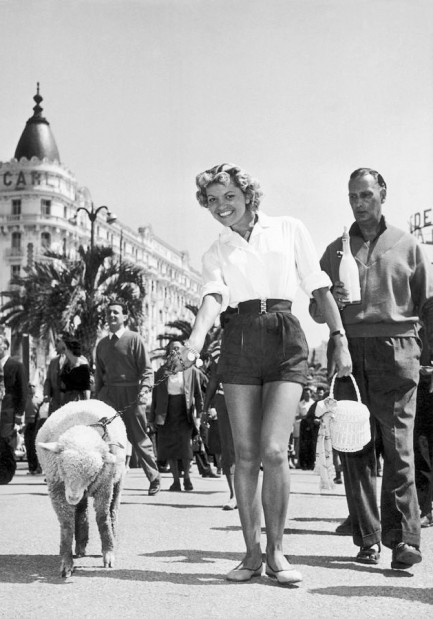 Arlette Patrick figures out a different way to generate publicity—by walking her sheep on the Croisette in 1955. Arlette Patrick figures out a different way to generate publicity—by walking her sheep on the Croisette in 1955.
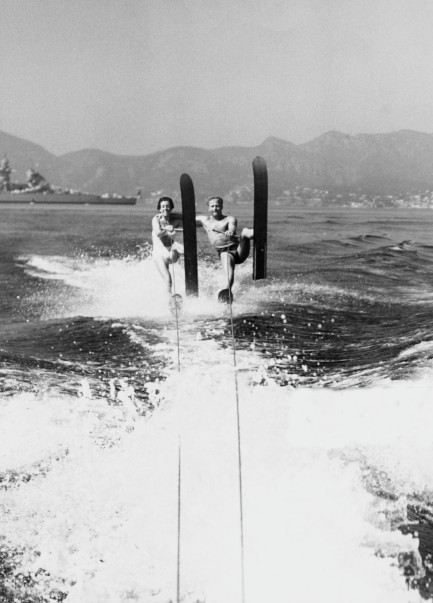 A pair of water skiers show perfect form in 1955, as a battleship floats in the background. A pair of water skiers show perfect form in 1955, as a battleship floats in the background.
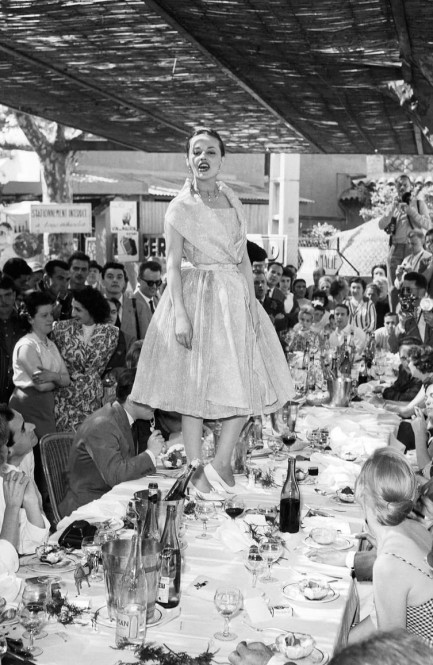 Jeanne Moreau, for reasons that are unclear, poses on a banquet table in 1958. Most sources descibe this in such a way as to make it seem spontaneous, but we have our doubts. It's a great shot, though. Jeanne Moreau, for reasons that are unclear, poses on a banquet table in 1958. Most sources descibe this in such a way as to make it seem spontaneous, but we have our doubts. It's a great shot, though.
 Two unidentified women take in the scene from the terrace of the Hotel Carlton, 1958. This shot is usually said to portray two tourists, but the woman on the left is the same person as in the bikini lunch shot from earlier, which tells us she's a model or actress, and both photos are staged. Like we said, publicity is everything in Cannes. Two unidentified women take in the scene from the terrace of the Hotel Carlton, 1958. This shot is usually said to portray two tourists, but the woman on the left is the same person as in the bikini lunch shot from earlier, which tells us she's a model or actress, and both photos are staged. Like we said, publicity is everything in Cannes. 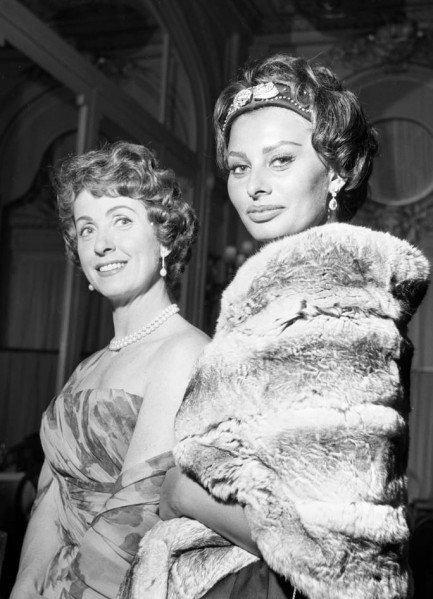 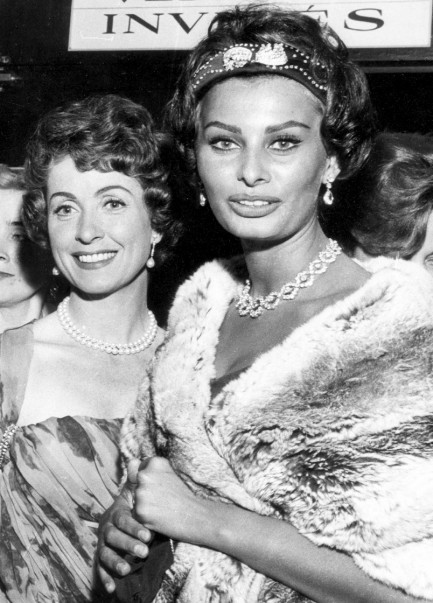 Danielle Darrieux and Sophia Loren at the 11th Cannes Film Festival, 1958. Danielle Darrieux and Sophia Loren at the 11th Cannes Film Festival, 1958.
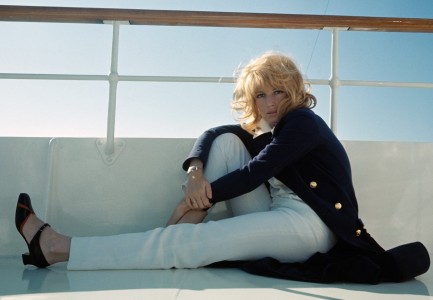 Italian actress Monica Vitti chills on a boat in 1968. Italian actress Monica Vitti chills on a boat in 1968.
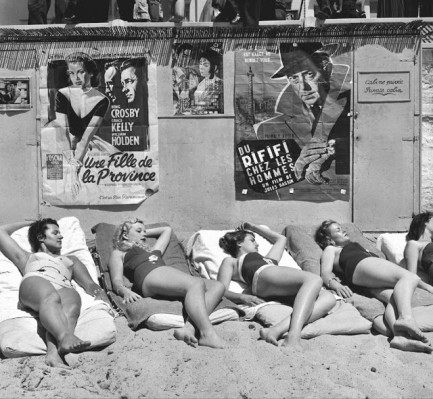 Aspiring stars catch some rays on the Croisette beach in 1955. The two large posters behind them are for The Country Girl with Grace Kelly, and Jules Dassin's Du rififi chez les hommes, both below. Aspiring stars catch some rays on the Croisette beach in 1955. The two large posters behind them are for The Country Girl with Grace Kelly, and Jules Dassin's Du rififi chez les hommes, both below.
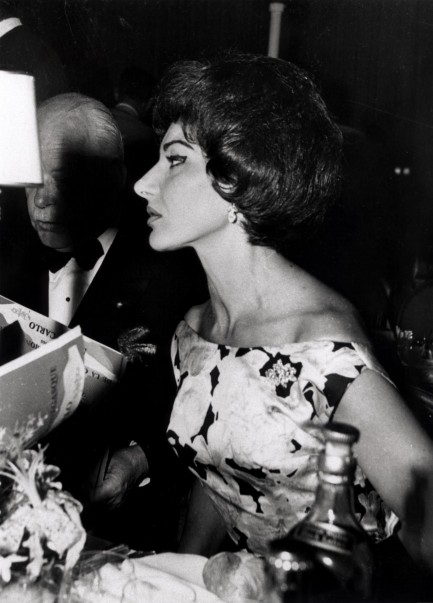 The renowned opera singer Maria Callas, 1960. The renowned opera singer Maria Callas, 1960.
 Kenneth Anger explores Hollywood's darkest recesses in his landmark tell-all. 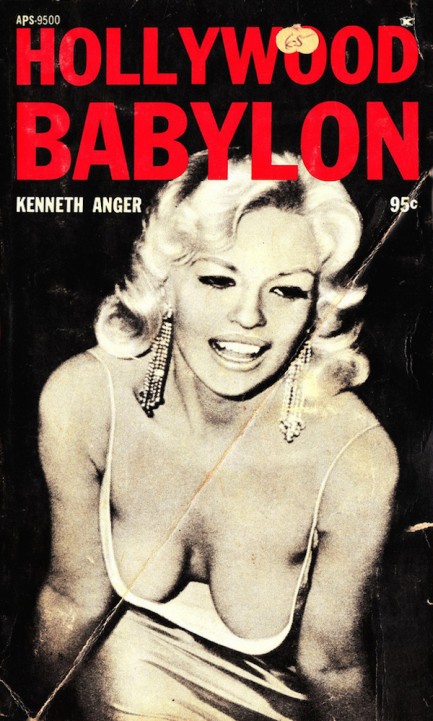
Kenneth Anger's Hollywood Babylon is the grandaddy of all Tinseltown exposés. It was published in 1965, banned ten days later, and shelved until 1975. It's exactly as advertised, outing everybody that was anybody for everything. Entire chunks are devoted to Charlie Chaplain, Lana Turner, Errol Flynn, Fatty Arbuckle and other cinematic luminaries. Some of its claims have been proved false—for instance the assertion that Lupe Velez died with her head in a toilet, and that Clara Bow screwed the USC football team (we doubt anyone really believed that one, even back then). But other tales are basically true, including accounts of various legal run-ins and feuds. Anger's writing is uneven, but at its most effective mirrors the type of pure tabloid style that influenced the likes of James Ellroy and others. Besides the salacious gossip the book has a ton of rare celeb photos, and those are of real worth. We've uploaded a bunch below. They came from a digital edition because our little paperback was too fragile to get on a scanner. By the way, don't feel as if we're working overtime on our website this Christmas morning—we uploaded everything in advance and are actually nowhere near a computer today. We're glad you took a minute to drop by. Copious vintage Hollywood below. 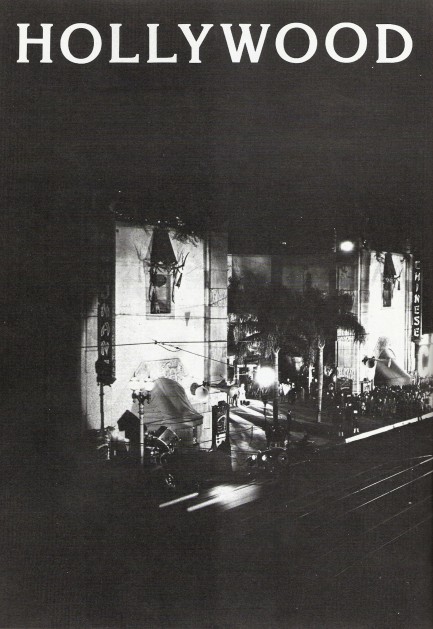 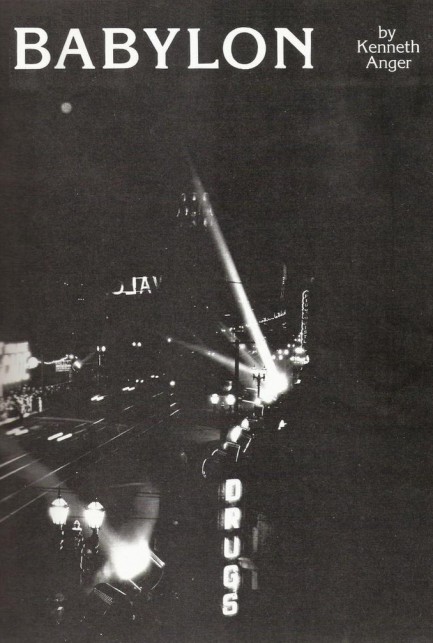 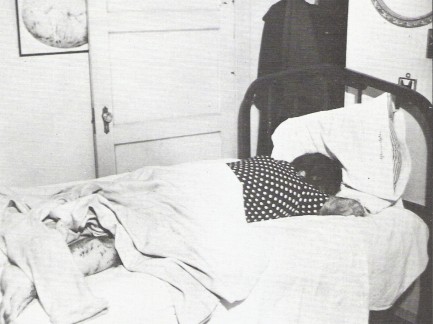 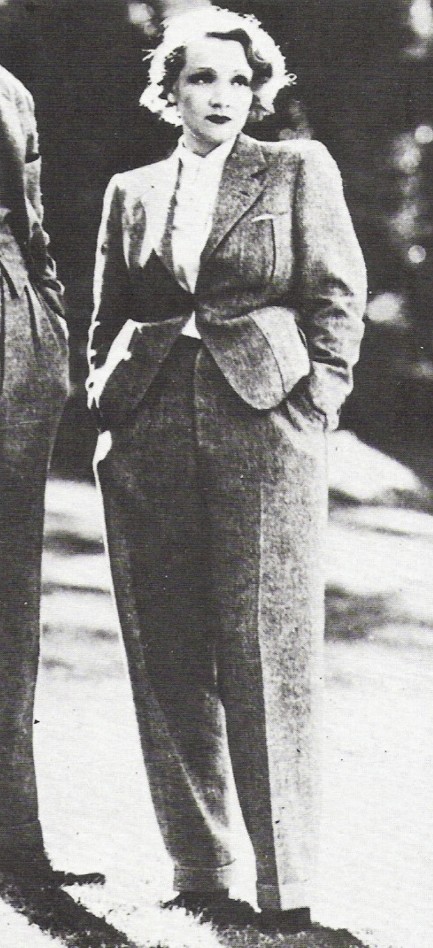 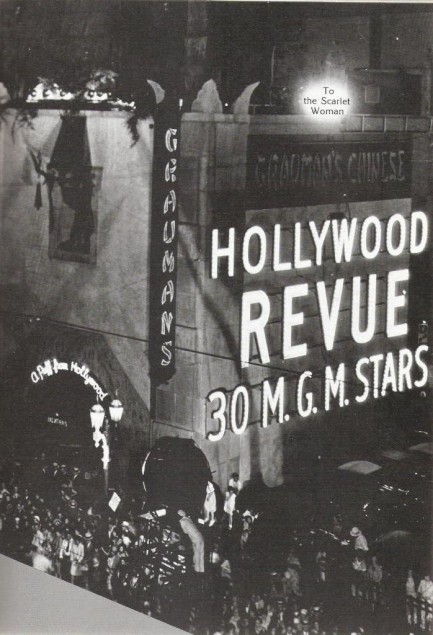 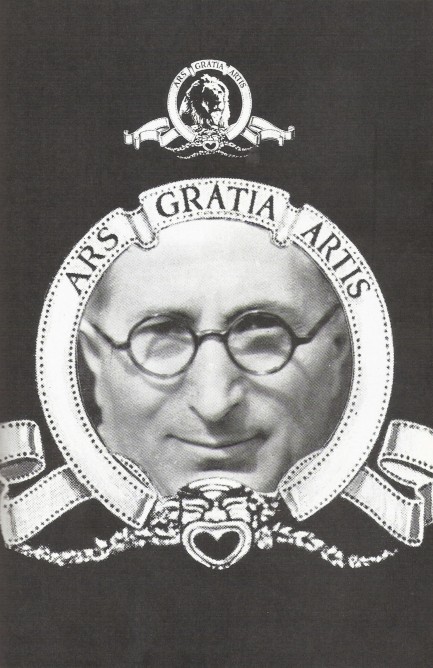 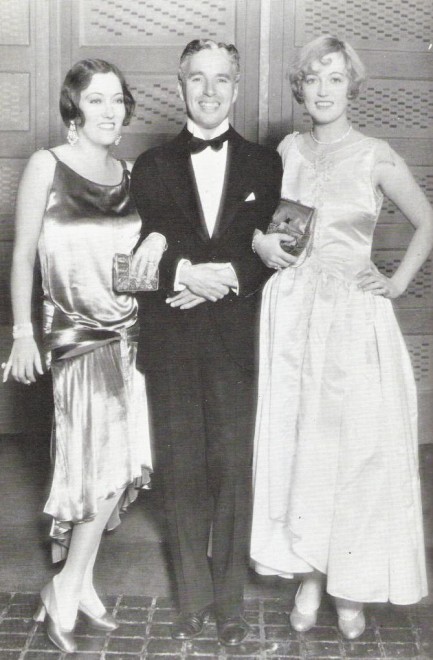 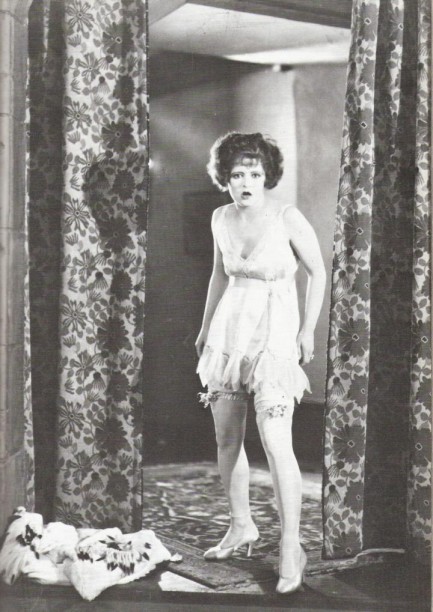 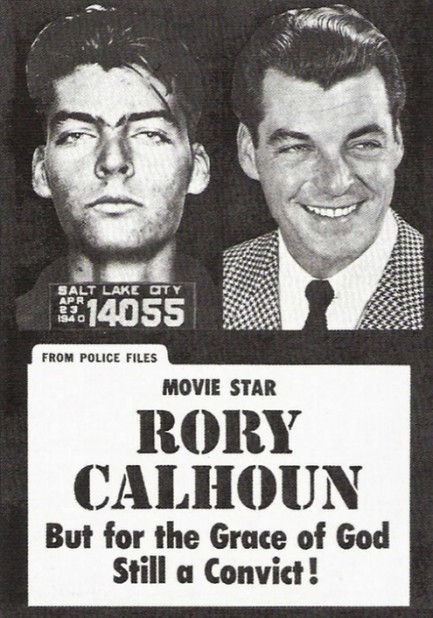 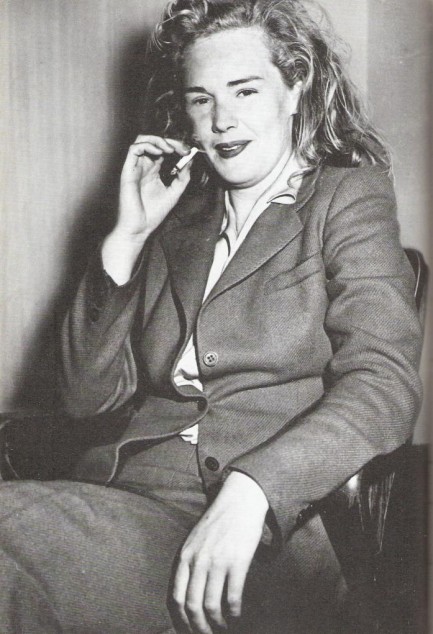 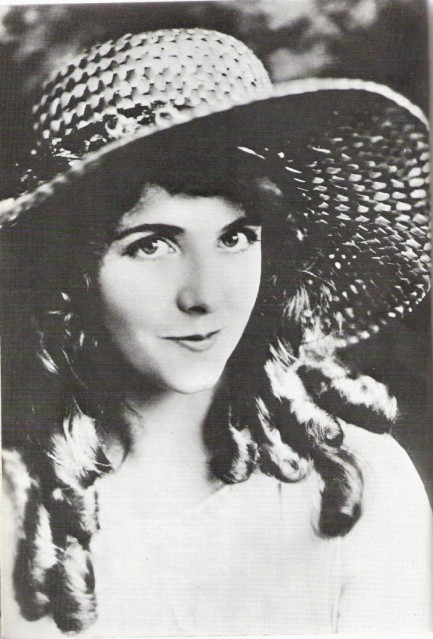 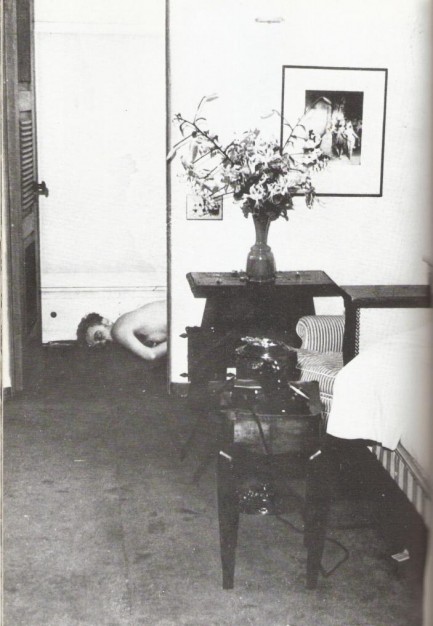 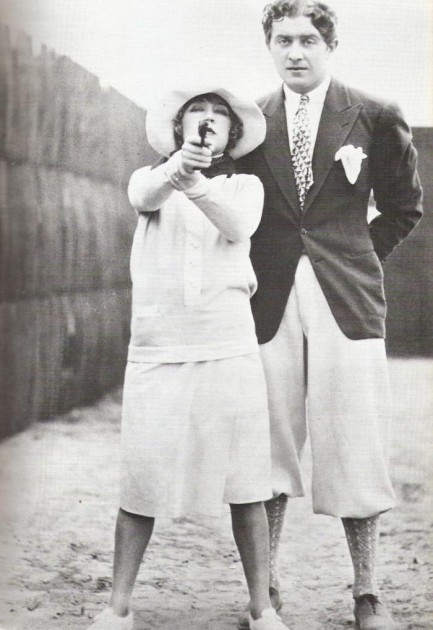 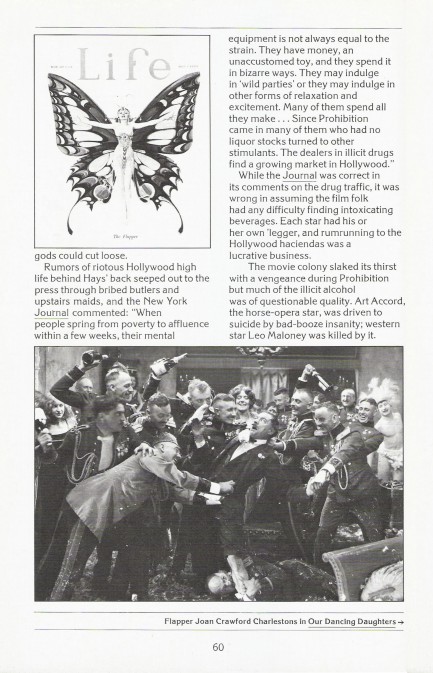 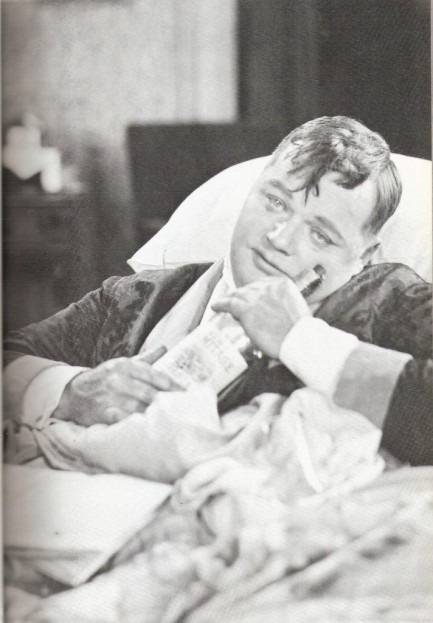 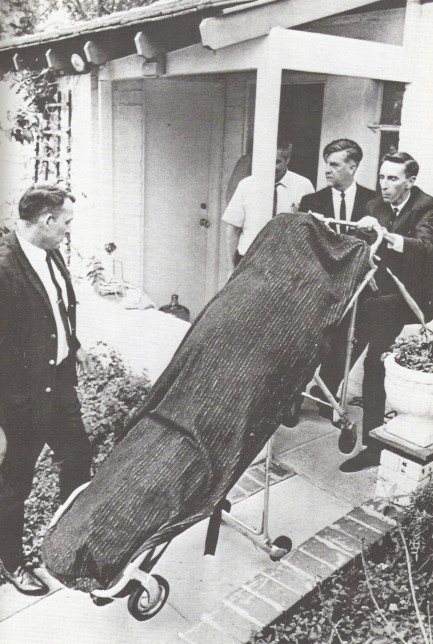 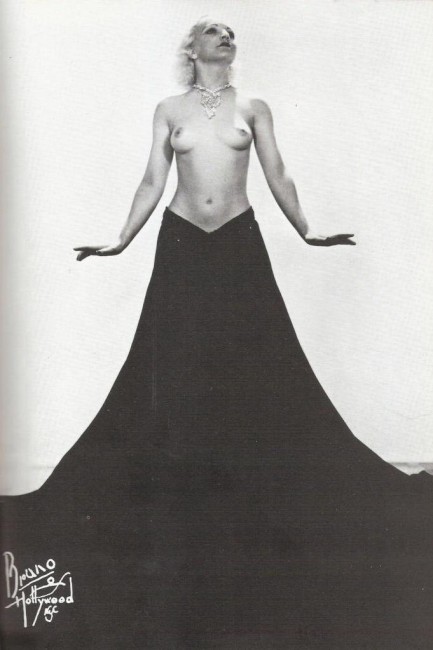 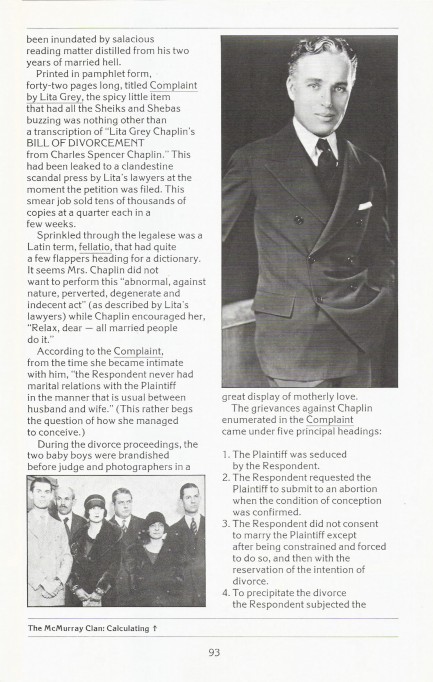 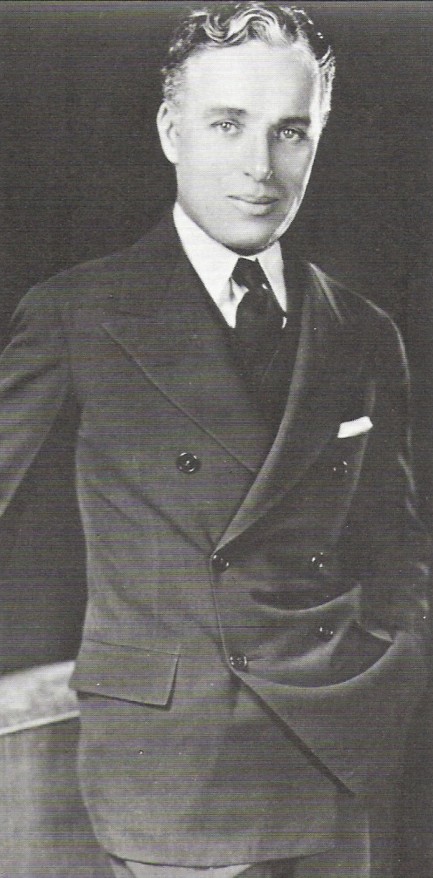 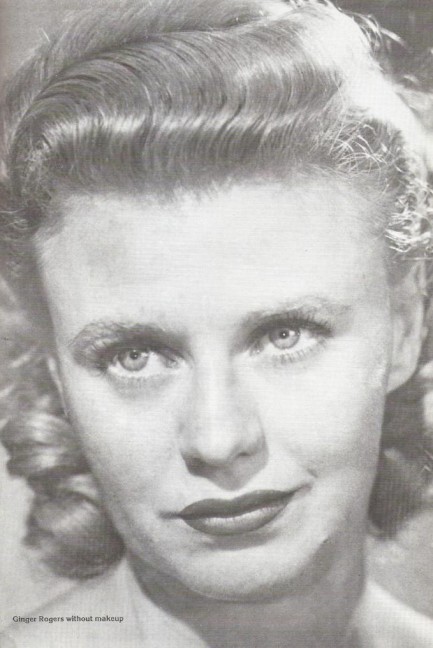 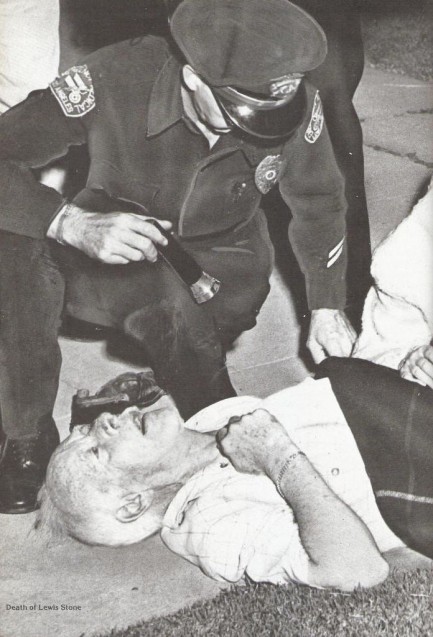 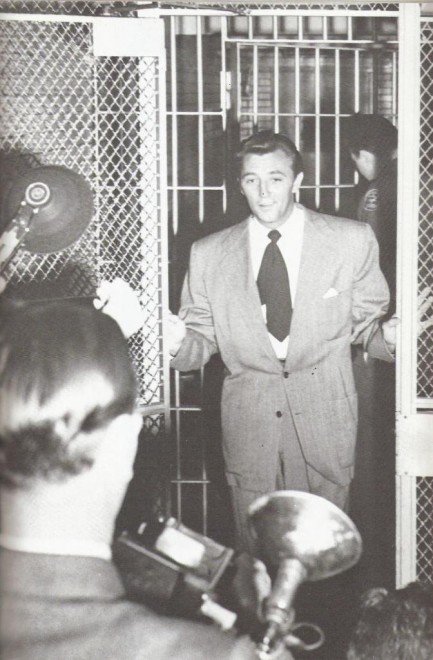 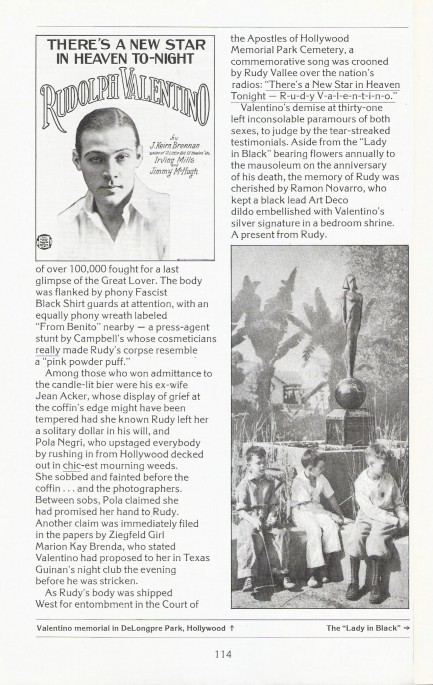 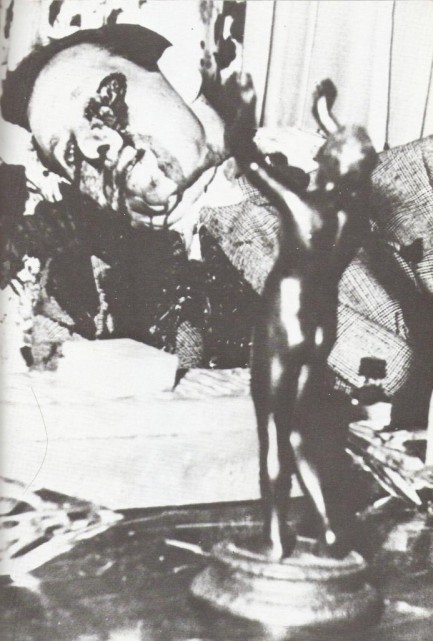 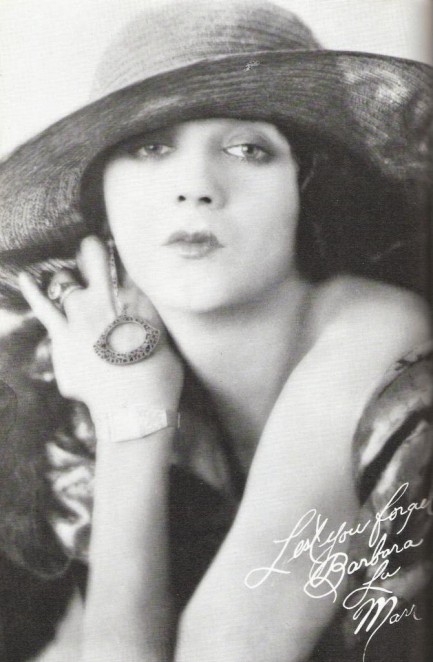 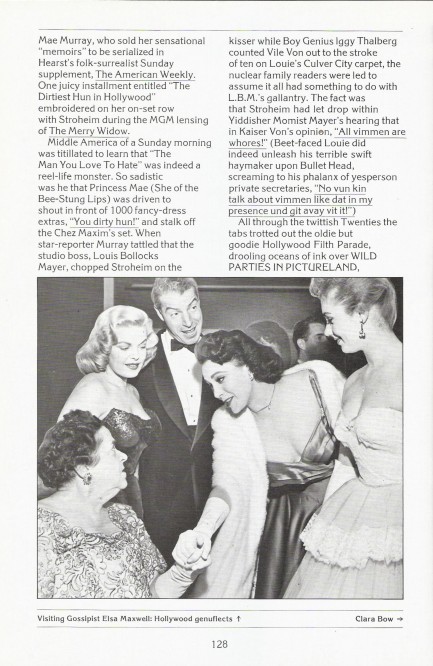 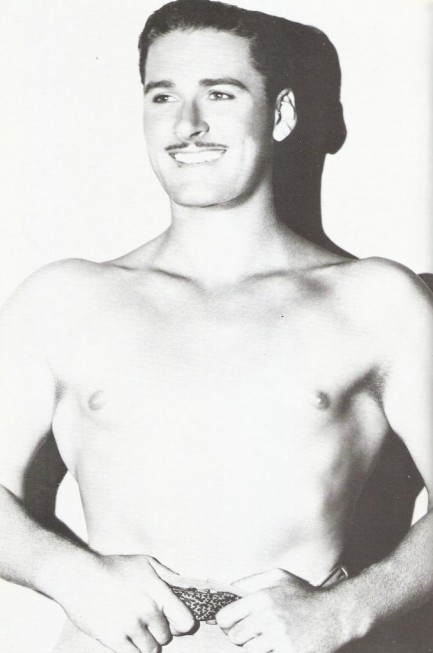 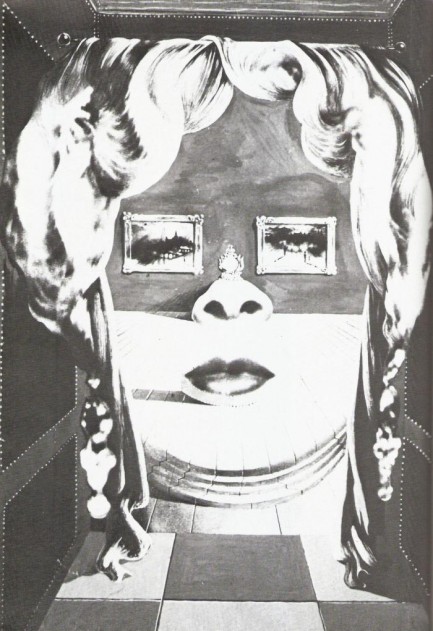 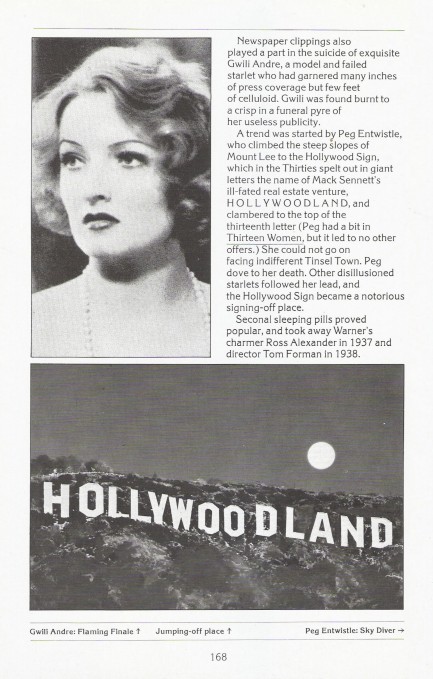 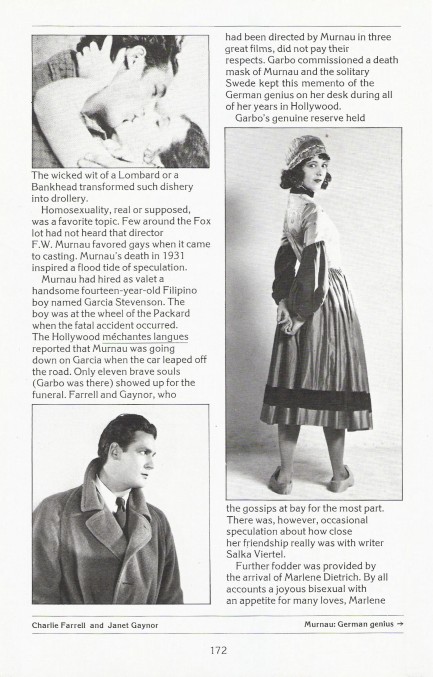 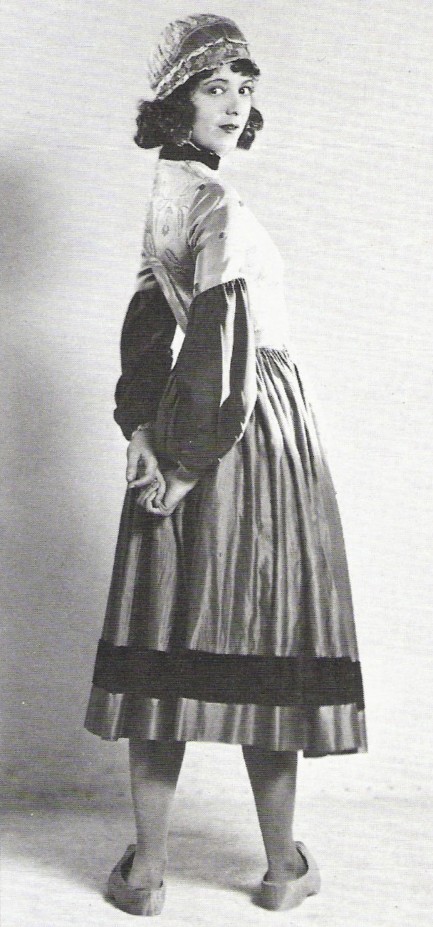 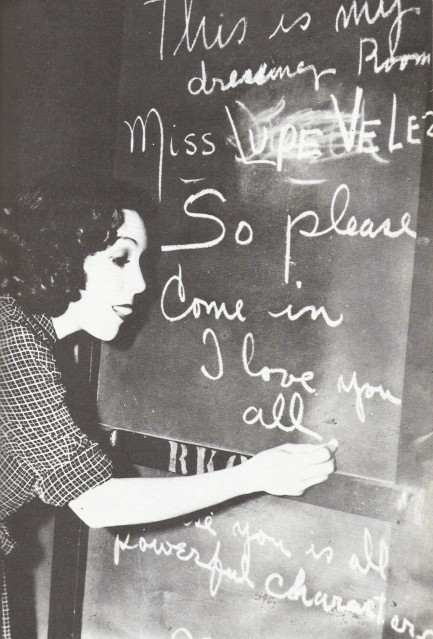 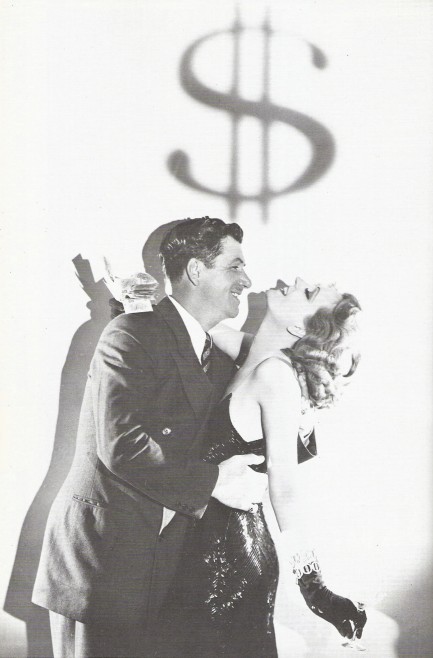 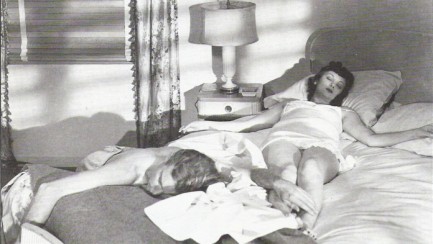 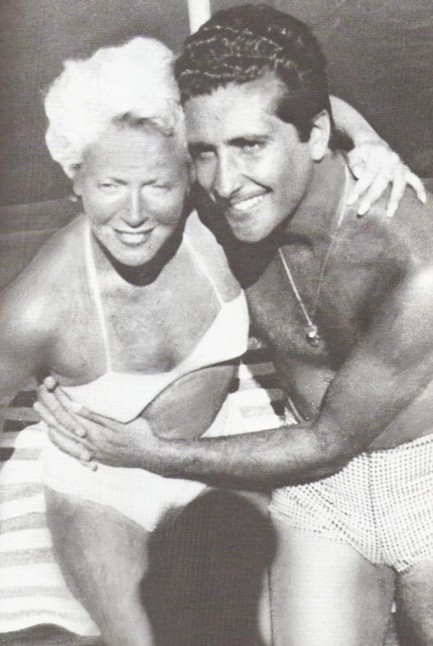 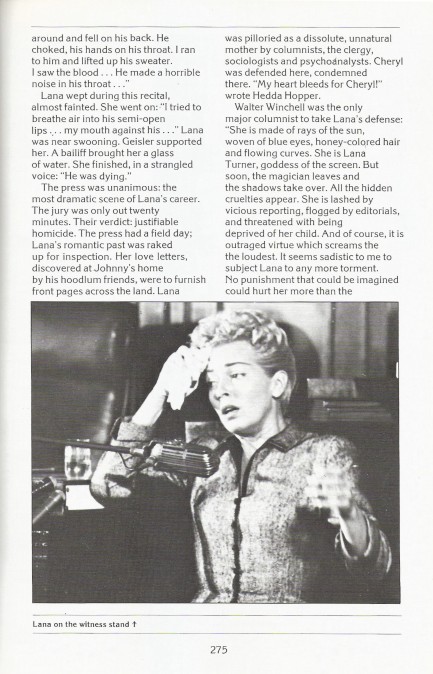 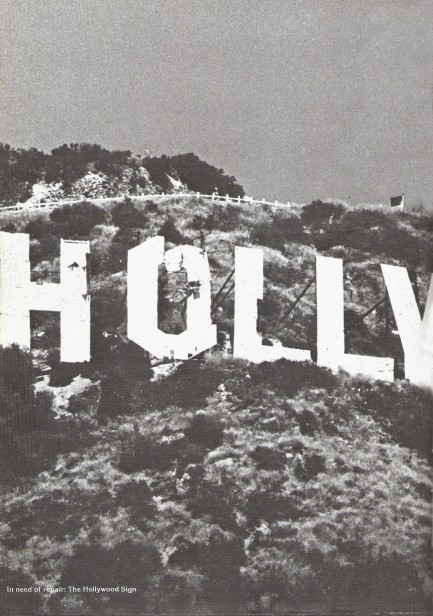 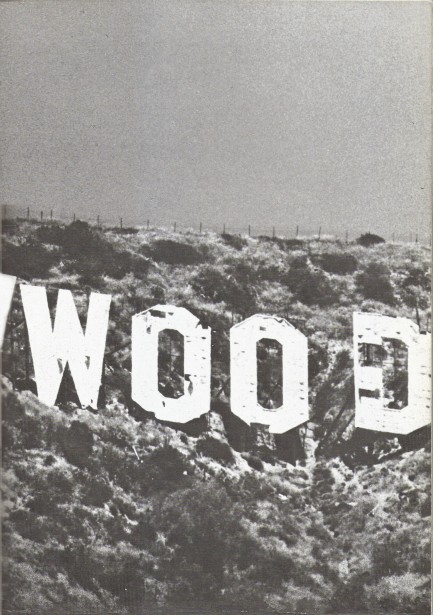
 Get in his way and he'll roll right over you. 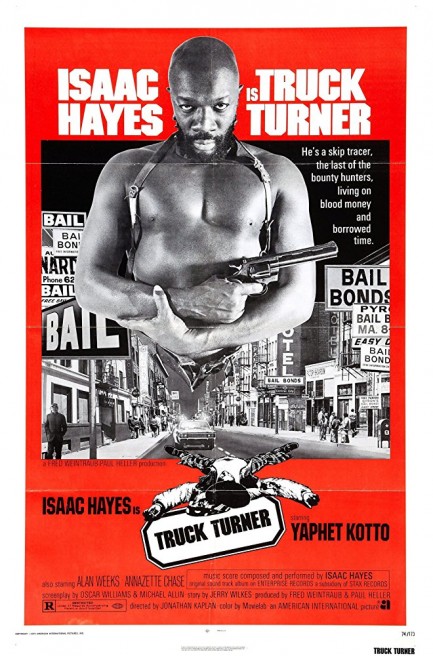
The movie Truck Turner was originally written to star Lee Marvin, Robert Mitchum, or Ernest Borgnine, but none of them were available. American International Pictures exec Larry Gordon reportedly said, “Well, we can't get any of them so now it's a black picture.” Marvin, Mitchum, and Borgnine were lucky they dodged this Truck. Isaac Hayes was signed up and he plays an L.A. bounty hunter who chases down a pimp named Gator only to end up pitted against a powerful madame named Dorinda. The movie is poorly put together, which you wouldn't guess from looking at its scores on sites like IMDB, where raters give it a 7.0. But we suspect those ratings derive from copious action and an amusingly bad script, particularly co-star Nichelle Nichols' tour de force segment in which, as Dorinda, she parades her whores before a group of pimps and describes their assets in a colorful monologue that's possibly the funniest moment from any blaxploitation movie. Here it is:
“Gentlemen, this is my family. These all prime cut bitches. $238,000 worth of dynamite. It's Fort Knox in panties. Candy did seventeen thousand last year. Velvet, Miss Sophisticate, did twenty. Used to be a Paris model. Jess and Annette each did twenty-two five. Show 'em your wares, bitch. [bitch licks lips, strikes a pose] See what you can get if you're good? That's Turnpike. She did twenty-six five. She's called Turnpike ’cause you gotta pay to get on and pay to get off. China, come here, baby. China did twenty-nine. Sweet piece a Oriental meat. Mmm, mmm, mmm. This is Frenchy. Gator used to call her Boeing 747. Show 'em why, bitch. [bitch shimmies] She did twenty-seven five. And that's sweet Annette. Show 'em that smile, you sweet thing. She did thirty thou last year. And where's my baby? That's Taffy. This bitch grossed thirty-seven thousand five hundred dollars working part time. Shit, her clients think she's too good to fuck. They call her Colonel Sanders because she's [bitch licks fingers] finger lickin' good.”
So that's pretty funny, in a horrible, un-2018 kind of way. The outtakes must have been uproarious. Nichols knocks this bit out of the park like a hanging curveball because she can act (in fact, watching how she makes those words sparkle is a clinic on the wide gap between screenwriting and an actor's interpretation). Yaphet Kotto as the pimp Harvard Blue makes his role work because he can act too. But nobody else can. Luckily, as action eventually overtakes dialogue matters improve considerably, with the last third of the movie developing enough momentum to sustain viewer interest. There's one other asset too—Hayes' groovy soundtrack. But you don't have to watch the movie to enjoy that, or Nichols' monologue, which you can watch at this YouTube link while it lasts. It starts about forty seconds in. Otherwise, we recommend giving Truck Turner a pass unless your sense of humor is—like ours—inclusive of semi-inept Hollywood obscurities. If that's the case, roll on. Truck Turner premiered in the U.S. in 1974. 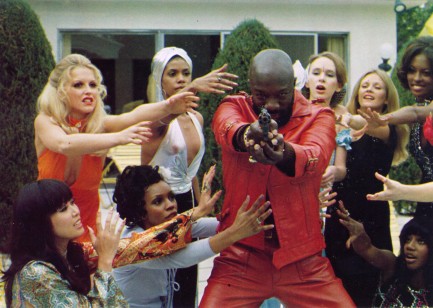 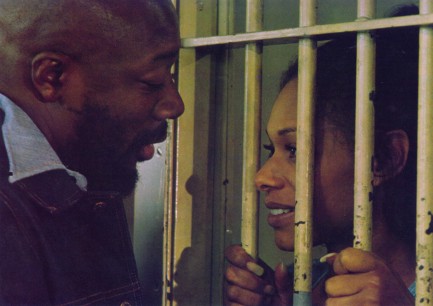 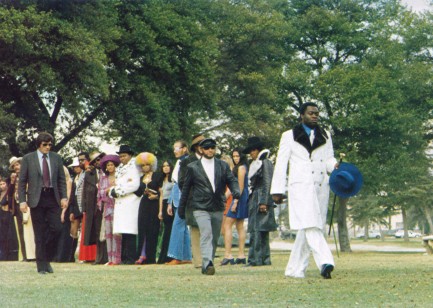 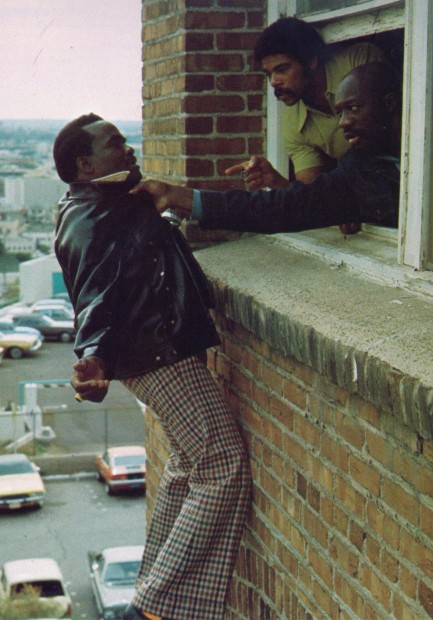  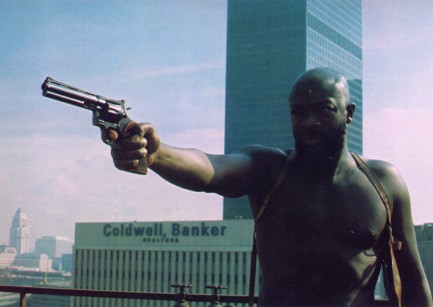 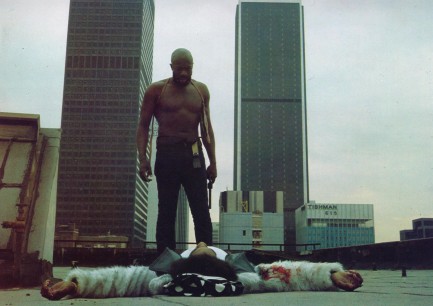 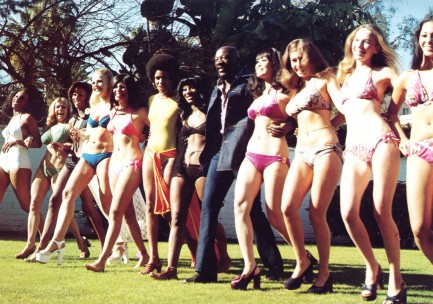 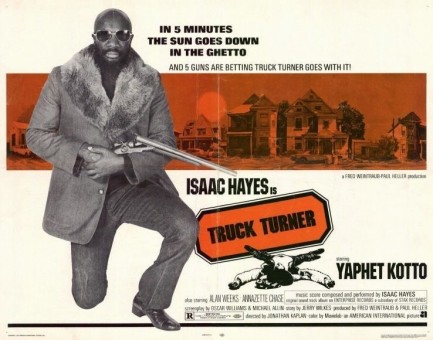
 Wherever celebrities misbehave National Spotlite is on the scene. 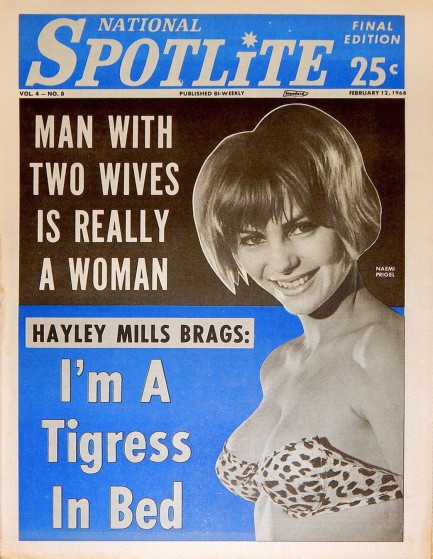
This National Spotlite published today in 1968 features cover star Naemi Priegel, a West German television actress and singer who reached the height of her fame during the 1970s. Inside are many interesting Hollywood tidbits, including former child star Hayley Mills allegedly describing herself as a tigress in bed, Marlon Brando beating up two party crashers, Elvis Presley breaking the arm of someone to whom he was demonstrating a karate hold, Richard Burton being pursued by a chorus girl who claimed he fathered her child, Gene Tierney and her husband Howard Lee getting into a public spat, and John Wayne slugging an autograph seeker who mistook him for Robert Mitchum. Was any of this stuff true? We have no idea, but it sure is interesting reading. You can see more in the same vein at our tabloid index, located at this link. 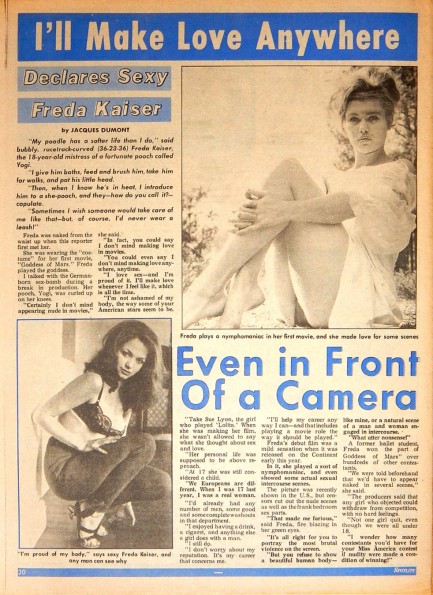
 |  |
|
 |

The headlines that mattered yesteryear.
1939—Batman Debuts
In Detective Comics #27, DC Comics publishes its second major superhero, Batman, who becomes one of the most popular comic book characters of all time, and then a popular camp television series starring Adam West, and lastly a multi-million dollar movie franchise starring Michael Keaton, then George Clooney, and finally Christian Bale. 1953—Crick and Watson Publish DNA Results
British scientists James D Watson and Francis Crick publish an article detailing their discovery of the existence and structure of deoxyribonucleic acid, or DNA, in Nature magazine. Their findings answer one of the oldest and most fundamental questions of biology, that of how living things reproduce themselves. 1967—First Space Program Casualty Occurs
Soviet cosmonaut Vladimir Komarov dies in Soyuz 1 when, during re-entry into Earth's atmosphere after more than ten successful orbits, the capsule's main parachute fails to deploy properly, and the backup chute becomes entangled in the first. The capsule's descent is slowed, but it still hits the ground at about 90 mph, at which point it bursts into flames. Komarov is the first human to die during a space mission. 1986—Otto Preminger Dies
Austro–Hungarian film director Otto Preminger, who directed such eternal classics as Laura, Anatomy of a Murder, Carmen Jones, The Man with the Golden Arm, and Stalag 17, and for his efforts earned a star on Hollywood's Walk of Fame, dies in New York City, aged 80, from cancer and Alzheimer's disease. 1998—James Earl Ray Dies
The convicted assassin of American civil rights leader Martin Luther King, Jr., petty criminal James Earl Ray, dies in prison of hepatitis aged 70, protesting his innocence as he had for decades. Members of the King family who supported Ray's fight to clear his name believed the U.S. Government had been involved in Dr. King's killing, but with Ray's death such questions became moot.
|

|
|

It's easy. We have an uploader that makes it a snap. Use it to submit your art, text, header, and subhead. Your post can be funny, serious, or anything in between, as long as it's vintage pulp. You'll get a byline and experience the fleeting pride of free authorship. We'll edit your post for typos, but the rest is up to you. Click here to give us your best shot.

|
|



























 the place because it was feminine, and because it had space for her two dogs. She also admitted that she used marijuana, which considering she hadn't gone to trial yet maybe wasn't a great idea.
the place because it was feminine, and because it had space for her two dogs. She also admitted that she used marijuana, which considering she hadn't gone to trial yet maybe wasn't a great idea.



 Do you have someplace I can store this suitcase filled with my excess masculine heat?
Do you have someplace I can store this suitcase filled with my excess masculine heat? Sure, you can sit next to me. But first you have to sign a liability waiver in case you get scorched.
Sure, you can sit next to me. But first you have to sign a liability waiver in case you get scorched. You'll love this next trick. I put my finger in this cognac and it catches fire.
You'll love this next trick. I put my finger in this cognac and it catches fire. Hot as this guy is, I don't know whether to keep beating on him or start beating on me.
Hot as this guy is, I don't know whether to keep beating on him or start beating on me. And once I take your face off I'll be the hot one. I'll have it all! Respect, envy, women, excellent service wherever I go! The world will be mine! Mwahh hah hah! Haaaaaaaah haha hahah!
And once I take your face off I'll be the hot one. I'll have it all! Respect, envy, women, excellent service wherever I go! The world will be mine! Mwahh hah hah! Haaaaaaaah haha hahah!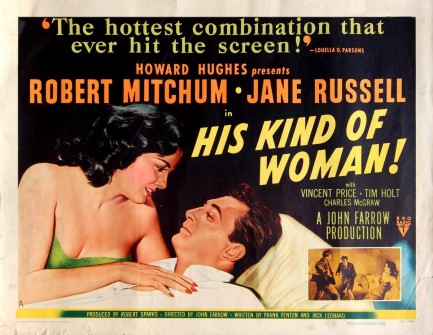



 Edith Piaf sings on the terrace of the Carlton Hotel on the iconic Boulevard de la Croisette at the first Festival de Cannes to be held under that name, in 1946. Back then the event took place in September and October, but would shift to May a bit later.
Edith Piaf sings on the terrace of the Carlton Hotel on the iconic Boulevard de la Croisette at the first Festival de Cannes to be held under that name, in 1946. Back then the event took place in September and October, but would shift to May a bit later.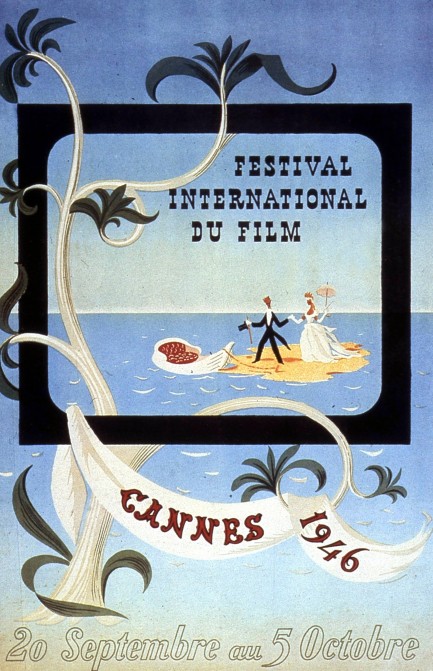
 Diana Dors and Ginger Rogers arrive at the fest the only way anyone should—breezing along the beachfront in a convertible, in 1956, with an unknown driver.
Diana Dors and Ginger Rogers arrive at the fest the only way anyone should—breezing along the beachfront in a convertible, in 1956, with an unknown driver. Kirk Douglas holds court on the beach in 1953, and Brigitte Bardot soaks up rays in the foreground.
Kirk Douglas holds court on the beach in 1953, and Brigitte Bardot soaks up rays in the foreground. Michele Morgan poses at the first Festival in 1946. Photo ops of this sort were essential sources of publicity for stars, and would soon become opportunities for non-stars seeking to be discovered.
Michele Morgan poses at the first Festival in 1946. Photo ops of this sort were essential sources of publicity for stars, and would soon become opportunities for non-stars seeking to be discovered. Case in point. Robert Mitchum poses with actress Simone Sylva in 1954. Sylva was allegedly not supposed to be there, but shucked her top and photo-bombed Douglas in an attempt to raise her profile. It didn't work. She made only a couple of credited movie appearances after her topless stunt.
Case in point. Robert Mitchum poses with actress Simone Sylva in 1954. Sylva was allegedly not supposed to be there, but shucked her top and photo-bombed Douglas in an attempt to raise her profile. It didn't work. She made only a couple of credited movie appearances after her topless stunt. Romy Schneider and Alain Delon at the 1959 fest.
Romy Schneider and Alain Delon at the 1959 fest. An unidentified model or actress poses in the style of Anita Ekberg from La dolce vita in 1960. This looks like it was shot at Plage du Midi, which is a beach located a little ways west of the Cannes town center.
An unidentified model or actress poses in the style of Anita Ekberg from La dolce vita in 1960. This looks like it was shot at Plage du Midi, which is a beach located a little ways west of the Cannes town center. A unidentified partygoer is tossed into a swimming pool after La Dolce Vita won the the 1960 Palme d’Or. The Festival is almost as well known for legendary parties as for legendary film premieres.
A unidentified partygoer is tossed into a swimming pool after La Dolce Vita won the the 1960 Palme d’Or. The Festival is almost as well known for legendary parties as for legendary film premieres.
 Another unidentified model or actress poses on the boardwalk in 1979. Generally, you don't have to be known to draw a crowd of photographers—you just have to be nearly bare. She's wearing lingerie, so that explains the interest, though this is modest garb for a Cannes publicity stunt. It's never a surprise to see a headline-seeking film hopeful strip all the way down to a string ficelle féminin, or thong, which is the limit of what is legal in Cannes
Another unidentified model or actress poses on the boardwalk in 1979. Generally, you don't have to be known to draw a crowd of photographers—you just have to be nearly bare. She's wearing lingerie, so that explains the interest, though this is modest garb for a Cannes publicity stunt. It's never a surprise to see a headline-seeking film hopeful strip all the way down to a string ficelle féminin, or thong, which is the limit of what is legal in Cannes Sidney Poitier and Jean Seberg have a laugh in 1961. This was the year Poitier's flick Paris Blues was released, so it's possible he had jetted down from the capital for the Festival.
Sidney Poitier and Jean Seberg have a laugh in 1961. This was the year Poitier's flick Paris Blues was released, so it's possible he had jetted down from the capital for the Festival. Philomène Toulouse relaxes on the sand in 1962 while a boy practices the classic French look of disgust he'll be using the rest of his life.
Philomène Toulouse relaxes on the sand in 1962 while a boy practices the classic French look of disgust he'll be using the rest of his life. Actor Bernard Blier, 1975.
Actor Bernard Blier, 1975. An unidentified bikini wearer boldly enjoys a lunch in a café on the Croisette, 1958.
An unidentified bikini wearer boldly enjoys a lunch in a café on the Croisette, 1958. Natalie Wood aboard a sailboat in 1962.
Natalie Wood aboard a sailboat in 1962.
 Grace Kelly, 1955.
Grace Kelly, 1955. Kelly times two—Grace Kelly and Gene Kelly, hanging out, also in 1955.
Kelly times two—Grace Kelly and Gene Kelly, hanging out, also in 1955. Sammy Davis, Jr. poses in front of a billboard promoting his film A Man Called Adam, 1966.
Sammy Davis, Jr. poses in front of a billboard promoting his film A Man Called Adam, 1966. Joan Scott gets sand between her toes in 1955. Scott is obscure. She isn't even the most famous Joan Scott anymore. The IMDB entry for the only Joan Scott near the appropriate age is for an actress born in 1920 who didn't begin acting until 1967. The Joan Scott above doesn't look thirty-five, though, and we doubt she would have been the subject of this somewhat well-known photo without parlaying it into a film appearance before twelve years had passed. So we don't think this is the Joan Scott referenced on IMDB.
Joan Scott gets sand between her toes in 1955. Scott is obscure. She isn't even the most famous Joan Scott anymore. The IMDB entry for the only Joan Scott near the appropriate age is for an actress born in 1920 who didn't begin acting until 1967. The Joan Scott above doesn't look thirty-five, though, and we doubt she would have been the subject of this somewhat well-known photo without parlaying it into a film appearance before twelve years had passed. So we don't think this is the Joan Scott referenced on IMDB.
 Sharon Tate, with Roman Polanski, and solo, 1968.
Sharon Tate, with Roman Polanski, and solo, 1968. Marlene Dietrich brings glamour to a tiki themed bar in 1958.
Marlene Dietrich brings glamour to a tiki themed bar in 1958.
 Tippi Hedren and Alfred Hitchcock release caged birds as a promo stunt for The Birds in 1963.
Tippi Hedren and Alfred Hitchcock release caged birds as a promo stunt for The Birds in 1963. Sophia Loren sits with husband Carlo Ponti, who was a member of the 1966 Festival jury.
Sophia Loren sits with husband Carlo Ponti, who was a member of the 1966 Festival jury. Raquel Welch poses on a motorcycle in 1966.
Raquel Welch poses on a motorcycle in 1966. Jane Birkin takes aim with one of her cameras in 1975.
Jane Birkin takes aim with one of her cameras in 1975. Dorothy Dandridge frolics in 1955, when she was promoting her film Carmen Jones.
Dorothy Dandridge frolics in 1955, when she was promoting her film Carmen Jones. Cinematic icon Catherine Deneuve and her sister Françoise Dorléac in 1965. Dorléac died in an automobile accident a couple of years later.
Cinematic icon Catherine Deneuve and her sister Françoise Dorléac in 1965. Dorléac died in an automobile accident a couple of years later. Robert Redford lounges on the beach in 1972. Based on his outfit you'd think he was in Cannes to promote The Sting, but he was actually there for his western Jeremiah Johnson, which screened May 7 of that year.
Robert Redford lounges on the beach in 1972. Based on his outfit you'd think he was in Cannes to promote The Sting, but he was actually there for his western Jeremiah Johnson, which screened May 7 of that year. Sophia Loren waves to well-wishers in 1964.
Sophia Loren waves to well-wishers in 1964. Bogie and Bacall paired up and looking distinguished in 1957.
Bogie and Bacall paired up and looking distinguished in 1957.
 John and Cynthia Lennon in 1965, and John with Yoko Ono in 1971. Every story John told on that second trip probably started with, “When I was here with the first love of my life...” until Yoko smacked him across the mouth.
John and Cynthia Lennon in 1965, and John with Yoko Ono in 1971. Every story John told on that second trip probably started with, “When I was here with the first love of my life...” until Yoko smacked him across the mouth. Rock Hudson and bicycle in 1966.
Rock Hudson and bicycle in 1966. Unidentified actresses pose on the beach in 1947. To the rear is the Hotel Carlton, mentioned in the Edith Piaf image, built on the Croisette and finished in 1910.
Unidentified actresses pose on the beach in 1947. To the rear is the Hotel Carlton, mentioned in the Edith Piaf image, built on the Croisette and finished in 1910. George Baker, Bella Darvi (right—your right, not his), and an unknown acquaintance have a surfside run/photo op in 1956.
George Baker, Bella Darvi (right—your right, not his), and an unknown acquaintance have a surfside run/photo op in 1956. Jayne Mansfield and Russian actress Tatiana Samoïlova enjoy a toast in 1958. Mansfield probably shared the story of how she once made Sophia Loren stare at her boobs, and Samoïlova said, “Cheers to you—well played, you provocative American minx.”
Jayne Mansfield and Russian actress Tatiana Samoïlova enjoy a toast in 1958. Mansfield probably shared the story of how she once made Sophia Loren stare at her boobs, and Samoïlova said, “Cheers to you—well played, you provocative American minx.” French actor Fernandel, whose real name was Fernand Contandin, on his boat Atomic in 1956.
French actor Fernandel, whose real name was Fernand Contandin, on his boat Atomic in 1956. Arlette Patrick figures out a different way to generate publicity—by walking her sheep on the Croisette in 1955.
Arlette Patrick figures out a different way to generate publicity—by walking her sheep on the Croisette in 1955. A pair of water skiers show perfect form in 1955, as a battleship floats in the background.
A pair of water skiers show perfect form in 1955, as a battleship floats in the background. Jeanne Moreau, for reasons that are unclear, poses on a banquet table in 1958. Most sources descibe this in such a way as to make it seem spontaneous, but we have our doubts. It's a great shot, though.
Jeanne Moreau, for reasons that are unclear, poses on a banquet table in 1958. Most sources descibe this in such a way as to make it seem spontaneous, but we have our doubts. It's a great shot, though. Two unidentified women take in the scene from the terrace of the Hotel Carlton, 1958. This shot is usually said to portray two tourists, but the woman on the left is the same person as in the bikini lunch shot from earlier, which tells us she's a model or actress, and both photos are staged. Like we said, publicity is everything in Cannes.
Two unidentified women take in the scene from the terrace of the Hotel Carlton, 1958. This shot is usually said to portray two tourists, but the woman on the left is the same person as in the bikini lunch shot from earlier, which tells us she's a model or actress, and both photos are staged. Like we said, publicity is everything in Cannes.
 Danielle Darrieux and Sophia Loren at the 11th Cannes Film Festival, 1958.
Danielle Darrieux and Sophia Loren at the 11th Cannes Film Festival, 1958. Italian actress Monica Vitti chills on a boat in 1968.
Italian actress Monica Vitti chills on a boat in 1968. Aspiring stars catch some rays on the Croisette beach in 1955. The two large posters behind them are for The Country Girl with Grace Kelly, and Jules Dassin's Du rififi chez les hommes, both below.
Aspiring stars catch some rays on the Croisette beach in 1955. The two large posters behind them are for The Country Girl with Grace Kelly, and Jules Dassin's Du rififi chez les hommes, both below.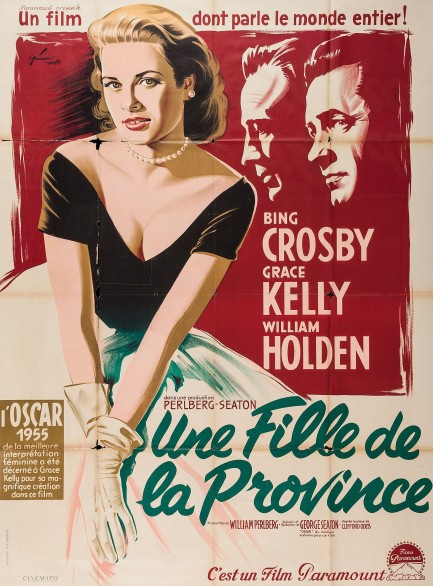
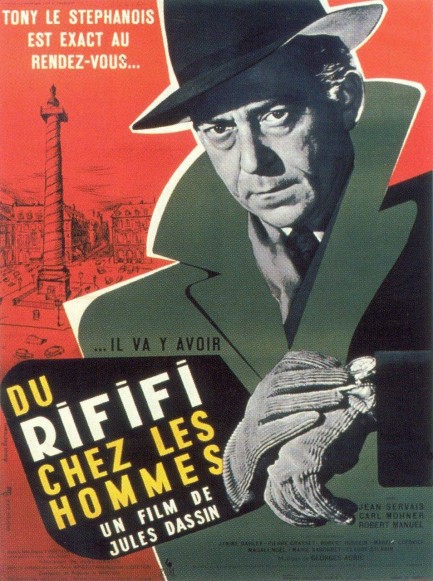
 The renowned opera singer Maria Callas, 1960.
The renowned opera singer Maria Callas, 1960.



























































































































